Mountaineer
CONSERVE in this issue: A Costume Climbing Tradition
Measuring Personal Growth on Ruth & Icy
Thinking Like a Glacier in the Sinlahekin Valley Conversations With Big Snow Mountain
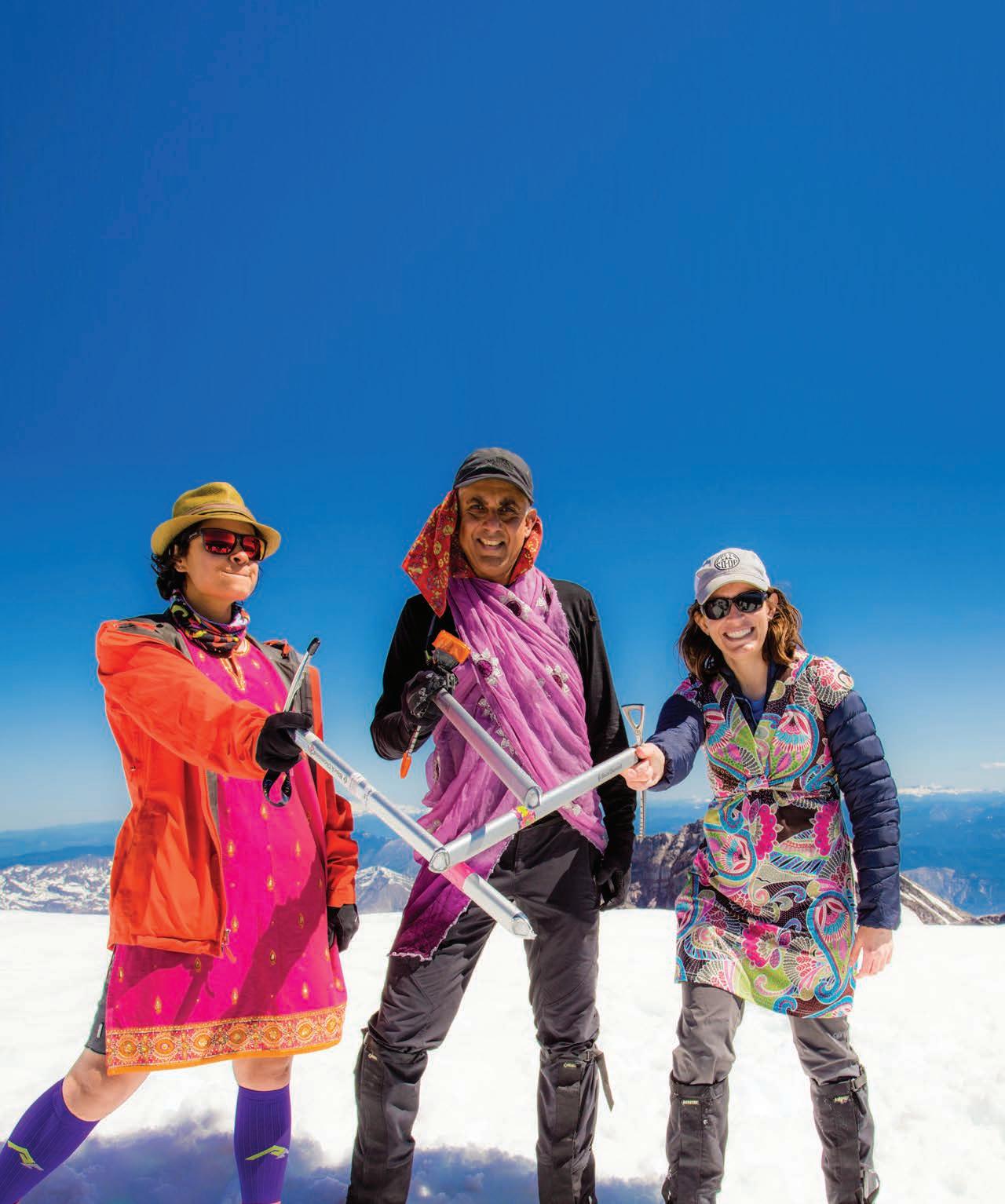
Spring 2024 • VOLUME 118 • NO. 2 WWW.MOUNTAINEERS.ORG EXPLORE • LEARN •
The Mountaineers enriches the community by helping people explore, conserve, learn about, and enjoy the lands and waters of the Pacific Northwest and beyond.



If you are thinking of joining, or have joined and aren’t sure where to start, why not set a date to Meet The Mountaineers? Check the Branching Out section of the magazine for times and locations of informational meetings at each of our seven branches.
32 22 28
Discover The Mountaineers
2024 | Volume 118 | Number 2
Spring
On the cover: Dress with an altitude - 8,365ft to be exact. Akanksha Panwar, Mushtaque Silat,
Mountaineer uses: tableofcontents AREA CLEAR Features 18 Measuring Personal Growth on Ruth & Icy 22 A Costume Climbing Tradition: Anywhere, Anytime 28 Thinking Like a Glacier in the Sinlahekin Valley
Conversations With Big Snow Mountain Columns 3 Tying In 4 Editor’s Note 5 Reader Feedback 6 Member Highlight Jason Naranjo 7 Peak Performance Food for Thought 8 Bookmarks & Staff Picks Alpine Rising: Sherpas, Baltis, and the Triumph of Local Climbers in the Greater Ranges 10 Youth Outside Meet the Members of Our Youth Team 12 Outside Insights Summiting With Servant Leadership 14 Impact Giving Ascending to New Heights 16 Conservation Currents Advocacy 101 27 Global Adventures Going Home to a Place I’d Never Been 36 Trail Talk Oh to Live on Bear Mountain 38 Retro Rewind A Date on Mt. Rainier 40 GoGuide How to Get Involved 46 Did You Know? Petrichor 2 mountaineer | spring 2024
and Lindsay Fincher on the summit of Mt. St. Helens, May 2016. Photo
by Mushtaque Silat.
32
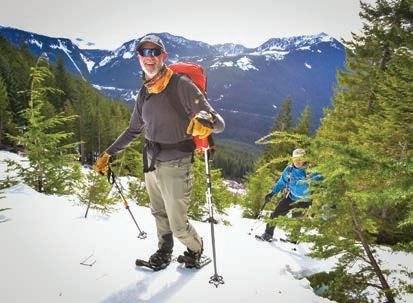
About a year ago, we unveiled our recently-updated strategic plan, Adventure with Purpose. We have shared the implementation plan details and progress toward our goals with our community in various ways, including at our Annual Meeting, at the State of the Organization presentation, and through blog posts. We’ve also been doing Adventure with Purpose updates at each of our board meetings, highlighting one of our three strategic priorities: Lead Innovation in Outdoor Education, Engage a Vibrant Community of Outdoor Enthusiasts, and Advocate on Behalf of the Natural World.
At our January 2024 board meeting, staff leadership shared highlights, challenges, and upcoming priorities related to our Lead Innovation in Outdoor Education (LEAD) strategic priority. One highlight was our change to incorporate organization-wide leadership award presentations into each of our seven branch banquets. This idea was largely based on feedback from leaders across the organization and was intended to further build community across The Mountaineers. Members of the board and staff leadership attended each branch banquet to help thank Mountaineers volunteers for their service to our community and to recognize branch and organization-wide leaders who have gone above and beyond.
As we recently shared in our LEAD update to the board, this branch banquet format was a huge success. Especially after a pandemic hiatus on most branch banquets, we heard from many people how nice it was being back together to celebrate our leaders, students, and The Mountaineers. I had the opportunity to attend both the Olympia and Kitsap banquets. Meeting folks I didn’t already know and reconnecting with others who I hadn’t seen in a while was a wonderful treat. I felt inspired hearing stories about the dedicated work by our volunteers to put on programs and help students become safe, responsible outdoor explorers. Each of our branches recognized leaders for exceptional service and it was an honor for me to recognize organization-wide leadership and service award winners.
Sometimes strategic plans can seem esoteric, non-specific, and without actionable outcomes. Our recent branch celebrations highlighted the fact that Adventure with Purpose is a tangible, forward-looking strategy rooted in our community, especially our leaders. Thank you to everyone who played a role in the branch banquets and to all our Mountaineer volunteers for your exceptional dedication to sharing your expertise and experience with our students.
As we look ahead, we will continue to work toward the vision laid out in our strategic plan. For the past 100 years, the core of our mission has been to connect people to the natural world and to each other. We envision a world where our adventures extend beyond the reach of our own personal enjoyment, where all people confidently enjoy and are inspired to protect the natural world, where we adventure with purpose.
 Tom Vogl Mountaineers CEO
Tom Vogl Mountaineers CEO
The Mountaineers is a nonprofit organization, founded in 1906 and dedicated to the responsible enjoyment and protection of natural areas.
EDITOR
Skye Michel
CONTRIBUTING EDITORS
Kristina Ciari, Bayley Stejer
DESIGNER
Sarah Kulfan, Beans n' Rice
CHIEF EXECUTIVE OFFICER
Tom Vogl
EXECUTIVE PUBLISHER
Tom Helleberg
DEVELOPMENT DIRECTOR
Bri Vanderlinden
PROOFREADER
Evy Dudey, Kate Regan
PUBLICIST
Kate Jay
BOARD OF DIRECTORS OFFICERS
President, Manisha Powar
Vice President, Rich Draves
VP of Governance, Roger Mellem
VP of Branches, Amanda Piro
VP of Outdoor Centers, Mark Kerr
Secretary, Vanessa Wheeler
Treasurer, Paul Stevenson
Retiring President, Gabe Aeschliman
DIRECTORS AT LARGE
Serene Chen
Dave Foong
Brynne Koscianski
Takeo Kuraishi
Maya Magarati
Alex Pratt
Sam Sanders
Mark Walters
Robert White
Anita Wilkins
Siana Wong
BRANCH DIRECTORS
Tim Schafermeyer, Bellingham
Ramki Pitchuiyer, Everett
Liz McNett Crowl, Foothills
Mark Goodro, Kitsap
Mike Riley, Olympia
Brad Near, Seattle
Mark Kerr, Tacoma
Mountaineer (ISSN 0027-2620) is published quarterly by The Mountaineers, 7700 Sand Point Way NE, Seattle, WA 98115. 206-521-6000.
Postmaster: Send address changes to Mountaineer, 7700 Sand Point Way NE, Seattle, WA 98115.
Periodicals postage paid at Seattle, WA.
Opinions expressed in articles are those of the authors and do not necessarily represent the views of The Mountaineers.
tying in
mountaineers.org 3
Photo by Rick Meade.


The theme for this edition is “conversations with the land.”
I’m beginning with the theme because being in conversation with the land is something I’m still coming to understand. Ecological literacy – part of which requires being able to read and understand the landscape – requires continuous engagement with and attention to your surroundings. I sheepishly admit that my mind prefers wandering to anywhere but where I’m meant to be paying attention.
For someone who likes to daydream a lot, I’ve learned that asking clarifying questions is a good way to convince someone you are listening. I’m not sure if this tactic applies to the land. I do ask the land questions like, “when will it be spring?,” “is this berry-looking fruit edible?,” and “can you confirm there’s no lurking lake monster with an appetite for my toes?” The answers come by trial and error, and with time. Flowers. An upset stomach. And I have yet to hear back on that last one. Jokes aside, I don’t know if an upset stomach qualifies as a conversation with the land. I do know that my connection to and confidence within the land could benefit from active listening.
I can’t read the land, but I enjoy reading the words of other’s who can. This edition has an inspiring array of authors who understand the land with reverence, empathy, intuition, and careful attentiveness. In “Thinking Like a Glacier in the Sinlahekin Valley,” naturalist Thomas Bancroft reflects on more-than-human timescales as he and other naturalists decode the geological history of the Sinlahekin Valley and the strength of the species within it. In “Measuring Personal Growth on Ruth & Icy,” Matt Dowell and friends read the
alpine and its challenging conditions with grace, thanks to the myriad skills acquired during our Basic Alpine Climbing course. In “Conversations With Big Snow Mountain,” nature photographer and backcountry skier Nick Aadland learns the satisfying dance of balancing personal will against the will of the mountains when a change-of-plans ultimately leads to an intimate connection with place. And “A Costume Climbing Tradition: Anytime, Anywhere” celebrates creative Mountaineers who embrace the mountains as a stage to dress up, play, and appreciate the people and places that give us so much.
Our regular columns offer their own takes on how a conversation with the land can manifest. A conversation can be a shared olfactory experience, such as petrichor, the sweet scent that fills our noses and signifies the oncoming of spring as explained in Did You Know. A conversation can look like devouring naturalist guides, watching wilderness docuseries, and visiting green spaces not too far from home, as Craig Romano reminds us in Trail Talk. And, a conversation can look like advocating in front of your representatives for the lands and waters you cherish, photographing vanishing glacial beauty in the alpine, or measuring the resilience of your stomach against the altitude.
Learning to be in conversation with the land involves patience, but we are all capable of speaking its language. Whether you err on the side of ecological fluency and can translate the cues of the terrain where you recreate, or are still discovering which stomach-cramp-inducing-berries to avoid consuming, there’s something to learn in every conversation. I hope the stories in this edition encourage you to tune your ears, open your eyes, and listen to what our lands and waters have to tell us.
 Skye Michel skyem@mountaineers.org
Photo by Eleanor Lewis.
Skye Michel skyem@mountaineers.org
Photo by Eleanor Lewis.
4 mountaineer | spring 2024 editors note
Tulips in the Skagit Valley. Photo by Skye Michel.

Each winter, we highlight photos from our favorite Mountaineers Instagrammers to inspire you into the new year. Participants and readers alike were thrilled to start 2024 with dreamy scenes from our photogenic corner of the Pacific Northwest. Want to be featured in next year’s “Top 10 Mountaineers of Instagram”? Tag us in your photos, or use our hashtag #OurPNW to be added to our running list of considerations.
“Thanks so much - humbled to be in this group of awesome adventurers.”
-Janette Powell, six-year member
“Stunning photos - in awe of both the talent to take them and the locations that inspired them!”
-Brad Peacock, six-year member and Foothills Branch Chair

In “The Bunion Chronicles,” mountaineer and three-year member Kiana Ehsani interviewed physical therapist and climber Grant Hennington about the diagnosis, treatment, and prevention of bunions. Readers wrote in with foot stories of their own, reminding us of the value in sharing our experiences... and selecting proper footwear.
“Interesting article. After years in figure skating boots, followed by years in ski boots as a ski instructor, I developed
‘reverse bunions’ on my little toes on both feet. Very painful and deformed my foot to the point where I could only wear sandals. Had foot surgery to correct the problem on both feet involving bone spur removal, breaking and realigning the metatarsal, then wiring everything together. That was 40 years ago. Have had no problems since but I am very careful with my footwear, especially hiking shoes.”
-Mary Klugherz,
Mountaineer reader

In the winter 2024 edition, we decided to print an all-time blog favorite, Thomas Bancroft’s “The Winter Solace of Birds.” The response from readers makes it clear why.
“Tom - Thank you for writing and sharing your very thoughtful ruminations. Reading your essay this morning resonated deeply for/with me, and is a gift I will carry with me. And kudos for the exquisite photos!”
-Julia Campbell, 31-year member
“This is a beautifully written article, Thomas. Your encouragement to slow down and look more closely, name things, and soak up the joys of nature is refreshing.”
-Julie Brockish, eight-year member
“Beautiful piece Tom. Thank you for writing it!”
-Valerie Bobb, six-year member
“Loved this article. You captured the joy of being a naturalist so artfully. Thank you!”
-Dawn Corl, four-year member and naturalist
“I loved this article & the photographs. Thank you!”
-Tanya King, three-year member
We value feedback from our readers, and we’d like to hear from you! Share your thoughts about Mountaineer magazine at magazine@mountaineers.org.
readerfeedback
mountaineers.org 5
Name Jason Naranjo
Hometown Grants Pass, OR
Member Since 2018
Occupation Associate Teaching Professor, Special Education & Disability Studies, UW Bothell, UW Seattle
Favorite Activities Alpine skiing, mountain biking, and hiking
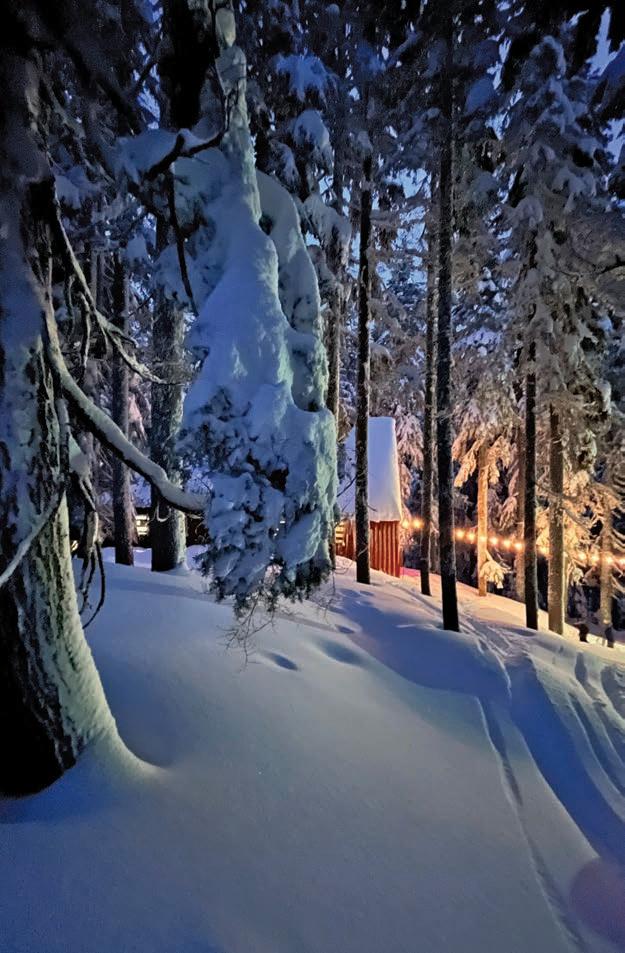
What first brought you to The Mountaineers?
Community, and the opportunity to teach and learn with others.
What is your favorite Mountaineers memory?
The collection of memories that I have with The Mountaineers are centered around Stevens Lodge. In 2018, I began volunteer ski instructing at Stevens Pass with the Outdoors for All Foundation. Once, after a full day of coaching and free skiing, fellow instructors asked me if I'd like to go night skiing with them and enjoy the plentiful snow that had been falling all day. I told them I needed to drive back to Seattle, as I did not have a place to stay on the mountain. They said, "Come and stay at Stevens Lodge with us!" From the moment I walked through the door at Stevens Lodge, I felt at home. Stevens Lodge is a place where community happens and people play, laugh, and work hard together. The memories I have and continue to create there are those of belonging and joy.
Who/What inspires you?
The pandemic took a toll on all of us; however, it also provided a unique opportunity for growth and transformation. During

the pandemic, I became more involved with Stevens Lodge as the Co-Chair of Facilities and Capital Projects. Continuing the work that had been started by other volunteers, I helped to organize and complete major improvements at the lodge. These included designing and remodeling the bathrooms, upgrading both plumbing and electrical systems, and decreasing our reliance on fossil fuel by 75% through the installation of an all-electric heating and cooling system. Through these projects, I came to learn more about the history of the lodge and the countless hours and resources that have been invested by generations of Mountaineers before me. I also had the opportunity to grow deep friendships and be mentored by fellow member, Jeff Bowman. I am inspired by the Stevens Lodge community, both past and present, and the dedication of Mountaineers who give collectively to create and maintain both physical and social spaces where people can learn, grow, and explore.
What does adventure mean to you?
Adventure to me means moving from the known to the unknown and creating a new path, a new way of being, and a new story.
Lightning round
Sunrise or sunset? Sunset
Smile or game face? Smile!
What's your 11th Essential? Gratitude
What's your happy place? Any wild place outside
Post-adventure meal of choice? Coffee and pastry
If you could be a rockstar at any outdoor activity overnight, what would it be? Any activity that would allow me to move through the landscape or water with sustained, fluid movement
Jason on a trip to New Mexico visiting ancestral homelands.
6 mountaineer | spring 2024 member highlight
Stevens Lodge nestled in the snow. All photos by Jason Naranjo.
Food for Thought
By Kelsey Hoffman, one-year member, ultra runner, and mountaineer
But what do you eat? This is my students’ favorite question when I tell them I’m running a 100-mile race. More than anything, they want to know what’s in store for my stomach (they care deeply about my stomach when I talk about mountaineering, too). If you’re also curious, here are my insights from years of running and mountaineering.
Carbo load
Runners are known to embrace pasta dinners the night before a big race. This strategy works for any lengthy outdoor endeavor. If you’ve got a long day ahead, treat yourself to a carb-heavy breakfast or lunch the day before. Pasta is a breakfast food, right?
Keep it simple
Plain tortillas. They might sound boring, but for long trail races, backpacking, and high-altitude mountaineering, I swear by them. Tortillas fold into your pocket and running bag, stuff into a bear can, and last for days without refrigeration. For nutrition, they’re simple carbohydrates. Add peanut butter and they can be a complete meal. While not the most appetizing, they won't make you sick.
Wise food choices
Bring what you love to eat! If you’re nauseous from high altitude or a strenuous run, what food can you handle? Forewarning: you might not like your chosen food after surviving on it for 30 hours, so “choose a food you can lose.” For example, I love my boyfriend’s chocolate chip cookies, but I choose to bring Metropolitan Market’s “The Cookie” because after consuming three-and-a-half of them while jogging in the heat, I can’t stand the idea of eating another (at least not until next year).
Weird food choices
Trail pizza: an unusual food choice I learned from The Mountaineers. People love it, but it doesn’t float my boat. I

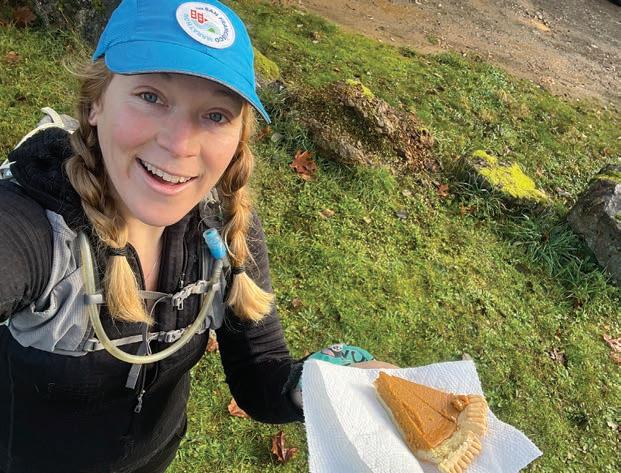
would rather have the “Dirty Turtle” special: a shot of maple syrup followed by a shot of pickle juice. The pickle juice provides essential electrolytes and salt; the maple syrup provides sugar for sustained energy. Other fun options include: hot pancakes (for overnight races), ramen noodles with veggie broth, salted mashed potatoes, grilled cheeses, and quesadillas with guacamole. Some races serve endless piles of Peanut M&Ms, Girl Scout Cookies, and homemade muffins. I’ve seen mountaineers eat some strange things (cold Chipotle burritos, Swedish Fish by the handful, a spoonful of coconut oil), but nothing like the hot food bar offered for ultra-runners at most 2am aid stations.
Vegan or not vegan? That is the question
If you live a plant-based life, the middle of your race might not be the right time to dive headfirst into a gooey grilled cheese sandwich. Check out vegan snack options before your run. Some include: Oreos (packed with sugar and an easily digestible carb), flour tortillas (check that they’re made without lard), baked potatoes, and watermelon. As a seasoned athlete, I eat mostly vegan. When racing, I try to listen to my body. If that grilled cheese speaks to me at 2am, maybe that’s what I need, but my drop bags are always stocked with my favorite vegan treats.
Test your palate
Mountaineers love a good campfire recipe exchange and can wax poetic about their exact breakfast recipes (mine is 1 cup of instant oats, 2 tablespoons of peanut butter, 1 teaspoon of chia seeds, and 1 mashed banana). Every post-trip gathering eventually involves a conversation about food: what you ate, what made you feel sick, what you couldn’t choke down no matter how hungry you were. Listen to others’ choices and try incorporating them into your own meal planning at home or on a conditioning hike. But whatever you do, don’t try a new food on race or summit day, or your next meal will be a generous serving of humble pie.
mountaineers.org 7
Kelsey enjoying her favorite Oreo flavor: Chocolate Peanut Butter Pie.
peak performance
Kelsey's fall favorite for trail races: pumpkin pie. All photos by Kelsey Hoffman.
K2 in Winter
By Bernadette McDonald
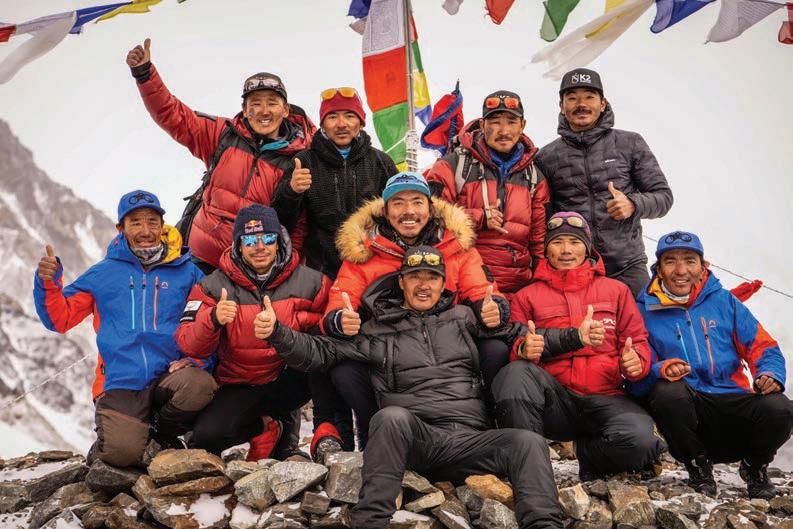
Excerpted from Alpine Rising: Sherpas, Baltis, and the Triumph of Local Climbers in the Greater Ranges (Mountaineers Books, March 2024).
On the morning of January 15, Mingma G, Mingma David, Mingma Tenzi, and Sona began fixing lines up toward Camp 4.
Mingma G described what happened next: “We followed the way to Camp 4 the same way we do in summer.” But this wasn’t summer. At this point, Mingma G was fixing and the others were assisting. After fixing 400 metres of rope, they were approaching the steep wall below Camp 4 when a problem arose: “We found a big crevasse, which was impossible to cross… We tried more on the right side, still the same. Then we descended back a little and tried to find a way on the left side — again it was the same so we descended all the way back to just above Camp 3.” This was a devastating situation since they essentially had to start all over again. Using what was left of the beautiful day, they persevered and fixed a completely new line up to Camp 4. Luckily, a serac had collapsed over part of the gaping crevasse, providing a tentative bridge. Exhausted from breaking trail and fixing lines, Mingma G stepped aside while Mingma Tenzi took over the lead.
At around 4 p.m. they arrived at Camp 4, the route fully equipped below them. “Our first reaction was winter K2 will be ours, and we hugged each other because we knew we would make the summit next day,” Mingma G said. Their efforts had been immense. The route from Camp 3 to Camp 4 usually takes two to three hours; they had taken eight. Still, he was elated. “We talked a little bit about our luck and hard work before descending. Whenever we are on the mountain, we pray to the mountain for our safety and we also pray for her to accept us. The Goddess K2 accepted us this time.” They
rushed down to Camp 3 and began preparing for the summit bid, which would begin in a matter of hours. The forecast for January 16 was even better than expected, so instead of starting at 11 p.m., their original plan, they felt comfortable delaying the start to 1 a.m.
Camp 3 began stirring at midnight. After the usual ordeal of lighting the stoves, boiling water, double- and triple-checking the contents of their packs, and then stuffing their feet into their high-altitude boots, they emerged from the tents, one by one. Nimsdai, Kili, Dawa Tenjin, Sona, Dawa Temba, and Mingma Tenzi left first. Mingma G came to the sad realization that his previous day’s efforts had so exhausted him that he didn’t feel strong enough to climb without oxygen. Disappointed, he fiddled with his oxygen regulator, which didn’t fit properly. He eventually found a spare regulator but chilled his fingers dangerously in the process of attaching it. By the time he was finally ready to start up, the others were already nearing Camp 4. It didn’t look like a promising summit day for Mingma G.
He left Camp 3 with Mingma David, Pem Chhiri, and Gelje. They reached Camp 4 two hours later and were shocked at the chilling effects of the wind. When Mingma G stopped for a few moments on the upper side of a crevasse while waiting for Mingma David, he became so cold he considered turning around. “I almost gave up there because I was worried to lose my toes.”
He checked his watch. It was 5 a.m. In another hour the sun would appear above the horizon, so he decided to continue, at least until dawn. At the same moment that he felt the first warming rays of the sun, the wind miraculously dropped. The four climbers stopped to soak up the rays and warm themselves before climbing up to the Bottleneck. The heat from the sun had given them extra energy and hope.
The Nepali team that made the first winter ascent of K2. Photo courtesy of the Mingma G Collection.
8 mountaineer | spring 2024 bookmarks
The first group was fixing lines up the Bottleneck, Mingma Tenzi leading the way. Mingma G’s group climbed toward them, finally catching up before the traverse. Nimsdai urged them on: “We all had that common pride, a common goal. This was for Nepal.” When they reached the small plateau 200 meters below the summit, they stopped to brew some tea. After resting a bit, Mingma Tenzi resumed fixing. They were still four hours from the summit.
They planned to stop around 10 meters from the top and continue as a group to the highest point. “We all started moving together and our 360 GoPro was on,” Mingma G said. “We then started moving towards the summit singing the National Anthem. This was my third time summiting on K2 but this time it was connected with the pride of the nation… It was a thrilling moment. I had tears in my eyes and my body was shaking itself, bearing goosebumps. No member in the team can explain the moment we had there.”
The ten Nepali climbers stepped onto the summit at 4:43 p.m., January 16, 2021. First winter ascent of K2.
Alpine Rising is available for purchase at our Seattle Program Center Bookstore, online at mountaineers.org/books, and everywhere books are sold. Join us in welcoming author Bernadette McDonald to the Seattle Program Center for a talk on March 14 at 7pm as part of our BeWild Speaker Series. Tickets are available at mountaineers.org/alpinerising.
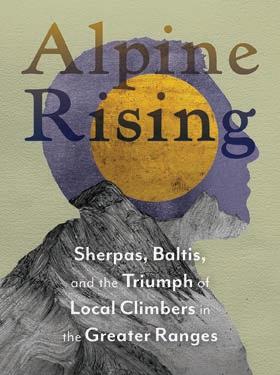

Climbing Self-Rescue: Essential Skills, Technical Tips, and Improvised Solutions
By Ian Nicholson
As the field of climbing self-rescue continually evolves, techniques must remain feasible for climbers to apply in the real world utilizing the gear they already have with them. With this in mind, elite climber Ian Nicholson has written the AMGA-approved Climbing Self-Rescue, an extensively illustrated guide sharing technical systems that follow easy-toremember patterns for solving a range of problems. Climbing Self-Rescue teaches the necessary skills to execute a successful rescue as a climbing team, including escaping the belay, lowering a climber, handling a stuck rope, improvising ascenders, rescuing an injured leader, and more.

Medicinal Plants of the Pacific Northwest: A Visual Guide to Harvesting and Healing with 35 Common Species
By Natalie Hammerquist
Crafted by expert forager and herbalist Natalie Hammerquist, Medicinal Plants of the Pacific Northwest provides a holistic approach to identifying, harvesting, and preparing natural medicines with common wild plants. Hammerquist's depth of experience is evident in the detailed visuals that aid step-by-step plant identification and herbal remedy preparation. Covering 35 common medicinal plants in the Pacific Northwest, Medicinal Plants highlights proper harvesting techniques, plant processing, and how to avoid toxic plant lookalikes. With a focus on ethical, seasonal, and sustainable harvesting, Hammerquist’s guide is a must have for foragers of all levels.

The Outdoor Leader: Resilience, Integrity, Adventure
By Jeannette Stawski
The Outdoor Leader is an exploration of resilience, integrity, and effective communication. Drawing on personal anecdotes and insights, Stawski demonstrates the need to integrate diversity, equity, and inclusion into outdoor leadership, and the power in doing so. Stories from Kenji Haroutunian, Stacy Bare, and others add diverse perspectives, emphasizing that the approach to leadership is not one-size-fits-all. Stawski's expertise shines through as she guides readers through informed decision making, championing a vision, and leading meaningful change. This guide is an invaluable resource for those seeking to grow in outdoor leadership roles.
staff picks
mountaineers.org 9
Meet the Members of Our Youth Team
Nearly thirteen years ago, The Mountaineers made a strategic investment in Youth Programs to offer more programming for our younger members. Since then, we’ve expanded youth programming in all branches and outdoor centers. With the help of volunteers, families, and staff, we now have opportunities for youth to explore the Pacific Northwest throughout the year. This year, we’ll have offered over 100,000 total youth experiences since the inception of these programs.
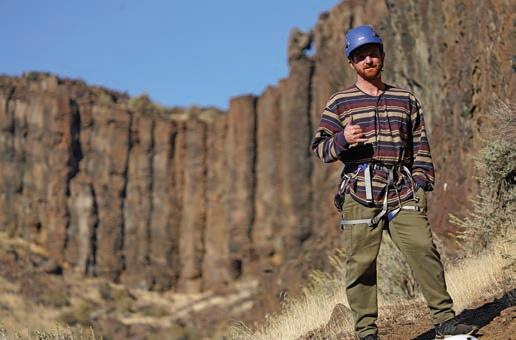
Zach "Farm" Jaffe
Hometown Laguna Beach, CA
Position at The Mountaineers I serve as Seattle’s Teen Clubs Coordinator. This means I manage the Mountaineers Adventure Club (MAC) and Jr. MAC. Through these programs, students learn a variety of outdoor skills including rock climbing, backcountry and cross-country skiing, mountaineering, and sea kayaking. We keep safety at the center of everything we teach and do. Fun fact: I was also the president of my school's Adventure Club in college, so this is a full-circle moment for me.
Favorite Activities Snowboarding, mountain biking, surfing, and sitting around a campfire
What brought you to work with The Mountaineers? What appealed to me most was the breadth of impact the organization has through a variety of avenues to foster positive change in the outdoors. From books to conservation to hands-on education, we really cover the gamut of possibilities. It makes me feel that my impact is amplified.
Why do you want to work with Mountaineers Youth Programs? I love working with youth for many reasons, but mostly because of their sense of humor. There's never a dull moment, and I find myself constantly laughing when out on trips with students. I also enjoy creating opportunities for youth to expand their realm of possibilities and foster knowledge and
We could not be more grateful to our Mountaineers community for your support as we expanded into new program areas, weathered a global pandemic, and sought out innovative ways to reach youth from all walks of life. To aid the growth of these programs, you may have seen a few new faces on staff. In this edition of Youth Outside, we’d love to introduce you to the new Mountaineers leading our Youth Programs.
curiosity. My goal is to empower youth to lead and teach these skills to others, which honestly comes naturally with this group. What does adventure mean to you? Adventure means following curiosity and being open to spontaneity. Sometimes it expands the comfort zone, but not always. Adventure can be as simple as walking out your front door with no plan for the day. I think it boils down to a variable mixture of some degree of unknown combined with some Type 1 and Type 2 fun.
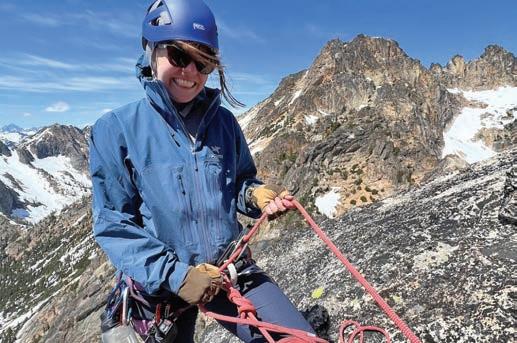
Claire Edwards
Hometown Jackson, MS
Position at The Mountaineers As the Olympia Youth Program Associate Manager, I facilitate and plan youth programming in Olympia including Summer Camps, Mountain Workshops, and Youth Clubs. I also lead activities with the Tacoma youth team and have wonderful mentors and leaders helping me be the best leader I possibly can.
Favorite Activities Hiking, climbing, backpacking, painting, and plant identification
What brought you to work with The Mountaineers? I was searching for fulfilling and meaningful work specifically with youth. The fact that The Mountaineers is an outdoor-centered organization was a joyful bonus. When I began, I was hoping to grow in leadership and outdoor skills, and to create a community with like-minded mountain enthusiasts.
Farm between belaying MAC students at Vantage. Photo by Emile Blouin.
10 mountaineer | spring 2024 youthoutside
Claire on Kangaroo Temple in the North Cascades. Photo by Nicole Fujie.
Why do you want to work with Mountaineers Youth Programs? These programs impact our community on a small and large scale. Introducing skills like problem-solving, leadership, and communication through rock climbing, backpacking, and hiking to those who might have never been exposed to these activities brings my heart so much joy. The conversations of belonging that occur during Summer Camp and Youth Clubs are everything and make the job all the more meaningful.
What does adventure mean to you? Adventure means participating in an activity that makes me feel alive. Adventure comes in many forms and occurs at many different speeds.

Trenton Bick
Hometown Sylvania, OH
Position at The Mountaineers I’m the Seattle Youth Clubs Coordinator. I oversee the Pathfinders, Nomads, and Explorers programs and plan and lead outdoor activities, trips, and workshops. I also coordinate the involvement of volunteer leaders and parents who lead activities for us.
Favorite Activities Fly fishing, hiking, and backpacking
What brought you to work with The Mountaineers? I’d known about The Mountaineers for a while before the idea of working here ever popped into my head. I knew the organization was well-respected in the Northwest outdoor community, but never thought I’d end up working here. I saw a job posting one day and thought, “Wouldn’t that be cool.” Now I’m here, and I’m totally loving it!
Why do you want to work with Mountaineers Youth Programs? I really enjoy working with kids and have had quite a bit of experience doing so. Kids are very funny, love to be silly, and are also very resilient, so it’s always a great time getting to work with them. Having the opportunity to coordinate programming and trips for Mountaineers Youth Programs was a no-brainer.
What does adventure mean to you? Adventure means going to unfamiliar (or sometimes familiar) places with an intent to seek out new experiences that are exciting and worth exploring.
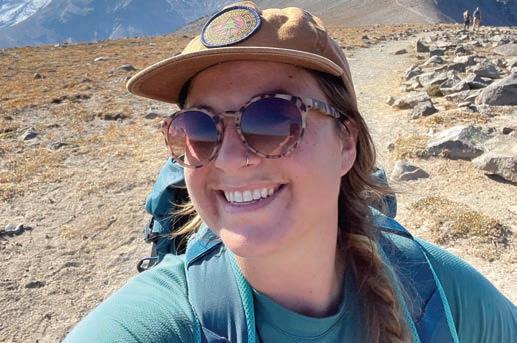
Leslie Gobel
Hometown Pacific Grove, CA
Position at The Mountaineers As the Overnight Camps Program Coordinator, I oversee the Overnight Summer Camps at Stevens, Meany, and Baker Lodges as well as the Mini Mountaineers program during the school year.
Favorite Activities Rock climbing, backpacking and hiking (particularly to swim spots), sea kayaking, surfing, and lizarding in the sun
What brought you to work with The Mountaineers? I recently completed a Master of Education from the University of Washington in Environmental Education and Nonprofit Management. I always cited The Mountaineers as an example when people asked me how I imagined merging all the aspects of my degree into a career. My goal was to be a part of an intentional community that provides accessible educational opportunities for people to explore the natural world, and The Mountaineers is doing just that.
Why do you want to work with Mountaineers Youth Programs? It is not lost on me that the experiences I had in the outdoors growing up were unique and privileged. The sense of comfort and safety I feel engaging in outdoor education and recreation is a direct result of the opportunities I had growing up. I hope to provide these same experiences to youth through The Mountaineers and foster another generation of confident, caring, and passionate outdoorspeople.
What does adventure mean to you? Saying “yes” to new experiences, ideas, and people, and being open to whatever the day brings (even if it ends up being Type 2 fun).
In addition to new members of Mountaineers staff, we’re launching new programs and opportunities for Mountaineers youth, including a day camp based in Renton to serve Foothills and south Seattle youth, expanded Overnight Lodge Camps, year-round clubs programs for Olympia, and more Partner Programs in Tacoma. Visit our website to learn more about these opportunities and how you can get involved.
Leslie enjoying a hike in Mt. Rainier National Park. Photo by Leslie Gobel.
mountaineers.org 11
Trenton climbing at Seneca Rocks, West Virginia. Photo by Joe Burson.
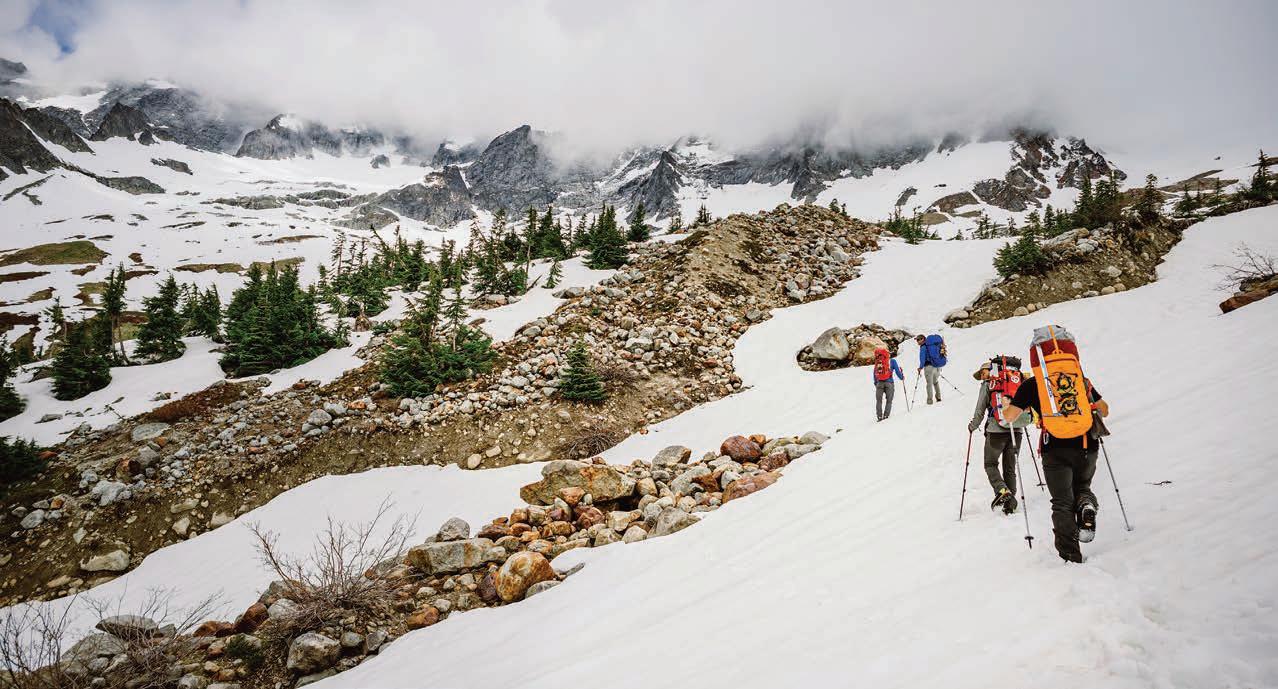
Summiting With Servant Leadership
By Priya Sinha, two-year member and Mountaineers Leadership Development Speaker
Mountaineering, an exhilarating and challenging pursuit centered around scaling towering peaks, transcends mere physical conquest. It embodies teamwork, resilience, and selflessness, all hallmarks of servant leadership.
Servant leadership is a leadership style first introduced by Robert K. Greenleaf in the 1970s. At its core, it encourages leaders to prioritize the well-being and development of their team members, with the leaders themselves taking on a role of service. Service to the team is a primary objective, and the summit is not merely a physical destination but a symbol of the group’s collective success. This approach emphasizes empathy, active listening, and a commitment to helping others succeed. As a Mountaineer, I’ve witnessed firsthand how servant leadership helps achieve outdoor goals. When fostering a culture of safety, cooperation, and personal growth, significant accomplishments follow.
Why servant leadership?
In my time as a Mountaineer, I’ve encountered exceptional instances of servant leadership that have left a lasting impact. During one of my first scrambles, I was afraid to ask questions because I thought my fear made me unworthy of being a Mountaineer. I remember “fessing up” that I was afraid to descend and in response, my instructors and leaders were kind, gentle, and provided unwavering support.
During another scramble, the leaders began the trip by assessing each member’s abilities. This enabled them to better accommodate participants' skill levels throughout the trip. Everyone reached the final destination because each individual felt seen and supported by their leaders. The moments when I see servant leadership in action are the moments I love being a part of The Mountaineers because
personal growth is not just an individual goal, it’s a shared aspiration – one that transforms a trip or course from a solitary pursuit to a collaborative adventure.
When servant leadership is not in place, the group suffers. I once attended a scramble that required last-minute changes due to a closed trailhead. The leader proceeded to choose a trail without providing information or seeking feedback from us regarding our skill levels and stressors. I had not seen a map of the trail and there was no way for me to assess whether it was a scramble I felt capable of doing. Participants began to struggle, and it heightened not only the participants' stress levels, but the leader’s as well. The leader's stress manifested as criticism directed at both the participants and their course instructors and leaders. The negative words impacted me, and I lost self-confidence in my scrambling. I did not feel physically or psychologically safe.
Servant leaders cultivate a sense of shared responsibility for each other's development, where teaching and learning is not confined to individual ambition but intertwined with the success and progress of the entire group. Servant leadership is a skill that most of us acquire through learning and experience. It is not an inherent skill, but a craft we must practice daily. Fostering a culture rooted in servant leadership is an ongoing journey, one that demands dedication and continuous refinement in every interaction.
As I reflect on my Mountaineers experiences, I am reminded that through my commitment to servant leadership, my leadership skills thrive, transforming any challenge I encounter – at The Mountaineers and beyond – into opportunities for growth and connection. By leading with actions rooted in empathy and conducive to growth, every Mountaineer can achieve their outdoor aspirations.
outsideinsights 12 mountaineer | spring 2024
Climbing into the clouds on Sahale.
Photo by Nate Derrick.
Priya’s Servant Leadership Pro-Tips
Be an active listener
Active listening is a vital skill for servant leaders, especially Mountaineers. Pay attention to what others say, ask clarifying questions, and provide feedback. By listening actively, you can understand your team’s needs and respond accordingly. Imagine leading hikers of varying expertise to a summit. In order to maintain the safety of the group, you must actively listen to each member's input and feedback to adjust the pace, route, and strategy accordingly, while also listening for signs of fatigue, stress, or fear that may affect the group’s safety. By listening actively, you ensure everyone is safe and motivated to confidently reach the summit.
Enact empathy
Empathy is vital. Being an empathetic leader means being able to understand someone else’s perspective. Imagine a scenario in which you are guiding three climbers. One is a beginner who has never traversed a glacier and is nervous about the crevasses and steepness of the slope. As a leader, you empathize with the beginner climber's feelings and reassure them they are well-equipped and trained, provide additional time for practice, assign a supportive buddy, and consistently check in to ensure their comfort and confidence. By showing empathy, you create a positive and supportive atmosphere for the whole group to fully enjoy the adventure.
Practice self-awareness
Self-awareness is the ability to think deeply about your behavior and how it affects the people around you. Accept and grow from your own weaknesses and extend this awareness to your team’s individual strengths and weaknesses for collective growth. Suppose you’re leading a group of paddlers and recognize you tend to be impatient and overconfident, putting your team at risk. By practicing self-awareness and listening to your group’s feedback, you can adjust your leadership style accordingly while improving your own performance and securing the wellbeing of your team.
Encourage growth
Effective servant leaders are committed to helping their teams develop by providing opportunities for their team members to learn new skills, gain new experiences, and overcome challenges. Offer your team guidance, training, and feedback, and encourage participants to take on leadership roles. Suppose you’re a Basic Alpine Climbing course leader instructing a group of new students. You know the students have never done a high-altitude activity before. Eager to improve the students’ skills and confidence, you teach them how to cope with altitude sickness and extreme weather conditions while also

assigning students to lead a section of the route. By offering your participants the opportunity for leadership and providing constructive feedback, you help the students grow as mountaineers and leaders.
Build community
Cultivate collaboration and engagement within your teams. Value the opinions of everyone and encourage participants to actively contribute. This approach enhances the team's collective wisdom, creativity, and problem-solving skills. A leader committed to building community knows that each member of the team has different perspectives, experiences, and expertise. For example, if you’re a mentoring leader, invite your mentee to plan the expedition, choose the route, and make strategic decisions. Create opportunities for the mentee to exchange feedback and support. By doing so, you build trust, respect, and cohesion, improving the chances that the mentee integrates into The Mountaineers community.
mountaineers.org 13
Priya hiking in Olympic National Park. Photo by Barney Kinzer.
Ascending to New Heights South Sound Youth Programs
By Alfe Wood, Associate Director of Development

On a wintry Saturday in Olympia, Claire Edwards, Mountaineers Youth Program Associate Manager, is getting kids and families stoked on snowshoeing during the “Ice Days” event at the Hands On Children’s Museum. It’s equal parts wonder, chaos, and pure delight as participants attempt walking in snowshoes on top of makeshift “snow.” While most participants have never snowshoed before, many leave excited to try this new activity with their family in real snow.
Makeshift “snow”shoeing is one example of how The Mountaineers partners with organizations to customize Mountain Workshops — donor-supported developmental, educational, and wellness programs that provide transformational outdoor learning experiences for youth who face significant barriers to outdoor recreation. Since 2011, we’ve strategically partnered with Puget Sound-area schools and youth-serving organizations to provide outdoor educational experiences such as hiking, rock climbing, stewardship projects, and more. We’ve invested in the South Sound specifically in recent years to partner with 37 organizations to give over 7,000 youth outdoor experiences, thanks in large part to the work by Mountaineers staff members Sarah Holt, RyAnn Peverly, and Claire Edwards to establish new and long-lasting community partnerships.
Getting youth outside is more important than you might realize
Getting kids outside has become an increasing priority for The Mountaineers, and for good reason. In 2023, researchers from the Aspen Institute found that fewer than one in five youth (19%) in Pierce County meet the Centers for Disease Control and Prevention’s guidelines for physical activity (one hour each day). Moreover, this finding is lower than both the state (23%) and national averages (24%).


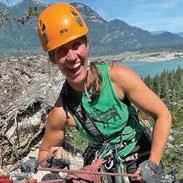
The consequences of spending less time outdoors are sobering. Without adequate “green time,” youth are at higher risk for sleep problems, attention disorders, childhood obesity, and mental and emotional disorders such as anxiety and depression. Outdoor experiential learning programs are critical because youth who spend more time outside experience life-long benefits in physical health, mental wellness, creativity, school engagement, and home life. “We’re trying to reach as many youth as we can,” said RyAnn Peverly, Tacoma Youth Programs Coordinator. “We want to show them there’s possibilities outside of what’s in their known world and that you don’t have to go too far from home to be able to do those things.”
The South Sound team’s work is supported by research as well. Studies have found that students who participated in outdoor education programs showed significant gains in interest in conservation, positive environmental behaviors at home such as recycling, and social benefits such as peer connection, community, motivation, and attitudes about school.
South Sound Mountain Workshops are meeting the need... and more
We designed Mountain Workshops to support youth to be courageous and vulnerable alongside a supportive community.
impactgiving
14 mountaineer | spring 2024
Left: Claire Edwards. Photo by Kristina Cirillo. Center: RyAnn Peverly. Photo by Kristina Cirillo. Right: Sarah Holt. Photo by Georgia Beard.
2023 SAMI students backing trip at Lower South Fork Trail. Photo by RyAnn Peverly.
The impacts we see are undeniable: when young people have a safe place to push their limits and engage in productive struggle to achieve common goals or overcome fears, they gain renewed confidence, hope, self-esteem, and a life-long interest in outdoor activities. Two educators and long-standing Mountain Workshops partners, Colin Horak from James Sales Elementary and Harris Levinson from Tacoma Science and Math Institute (SAMI), report that many of their students who participate in Mountain Workshops have increased classroom engagement and academic performance. “The Mountaineers helps us form a community so that those students know they are safe even as they ascend to new heights,” said Harris.
The unwavering value of outdoor spaces and its power to create thriving communities is also evident in our partnership with AMARA – an organization that supports children, adults, and families experiencing foster care. Last summer, we facilitated a Mountain Workshop for middle school-aged youth intended to address the stressors of experiencing foster care. RyAnn led participants through activities such as urban hiking, identifying local plants, creating nature journals, and forest bathing. Campers were encouraged to talk about what they heard, felt, and smelled while in nature, and then shown how those skills could be used to center oneself during stressful times without venturing far from home. Through experiential learning opportunities at Mountain Workshops, youth develop a deeper appreciation of health and wellness for both people and place and build critical skills as they become the next generation of leaders and change makers.
Beyond Mountain Workshops: Accessible year-round programming
Another space where South Sound youth gain confidence in the outdoors is through youth clubs such as Mountaineers Adventure Club (MAC), a year-round program for high school students. “The ongoing depth of experiences is so important,” shared Sarah Holt, Associate Director of South Sound Programs. “When we see kids day after day, multiple times a week, they get a chance to dive deep into a skill and gain enough experience that they feel confident to do an activity on their own. It becomes a part of who they are.” While the cost to enroll in youth clubs like MAC can be out of reach for many, Sarah and her team make it a priority to share scholarship opportunities through the Mountaineers Access Program (MAP) that make these programs more accessible.
Prior to 2023, Leo Brownawell had taken little interest in climbing, but during his high school senior year, Leo’s stoke was ignited during a multi-week Mountain Workshop at SAMI, where Mountaineers instructors helped him navigate the challenges of climbing. Encouraged by his teachers, Leo applied for and was awarded a scholarship to enroll in our MAC program to pursue the sport. After graduating from that program last September, Leo is now an avid climber and volunteer at his local climbing gym. There, he launched an adaptive climbing night for adaptive athletes to build community and explore climbing. As an adaptive athlete himself, Leo wanted to reach out to other adaptive climbers, create community, and raise awareness of adaptive climbing.
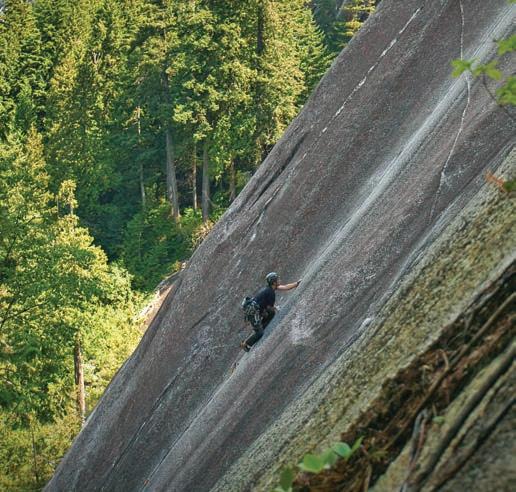

Leo credits his confidence and leadership skills to the support he received from his teachers, the Tacoma Mountaineers, and his time in MAC. “I was able to flourish and fully experience much more than just gym climbing.” Leo said. “My teachermentor encouraged me to start the adaptive climbing nights. Without their help and their long-standing relationship with The Mountaineers, those nights wouldn’t have happened. MAC also encouraged me to be a leader. Being an older member, I took on a leadership role for younger students and stepped up multiple times to give direction and make sure everyone was safe and having a great time.”
Your support makes this work possible
Many of our region’s children face significant obstacles to outdoor recreation. Through the generosity of donors and funders, our youth education teams are able to serve communities in the South Sound, Kitsap, Bellingham, and greater Seattle area with co-designed programs to increase the amount of time spent outside by youth, and address common barriers to outdoor recreation such as financial cost, access to transportation, gear and clothing, and trained instructors. “We want the outdoors to be a place where kids can show up as themselves without judgment and be outside with other people,” Claire said. “Mountain Workshops and our youth programs provide a way to give youth and families confidence that the outdoors is accessible.”
To learn more about or support youth programs and scholarships, visit change to mountaineers.org/scholarships.
mountaineers.org 15
Leo Brownawell climbing at Squamish, BC 2023. Photo by Kevin DeFields.
Tacoma MAC Member Kat Curry at Vantage, WA. Photo by Kevin DeField.
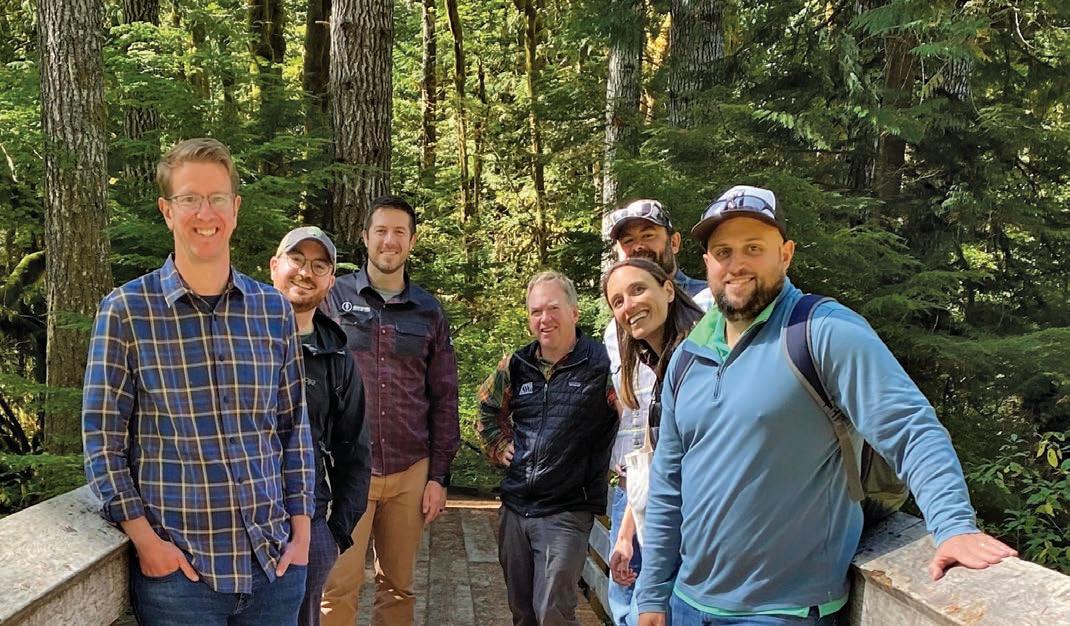
Advocacy 101
Learn How to Advocate for Public Lands with Our New eLearning Course
By Conor Marshall, Advocacy & Engagement Manager
It was a humid summer day in the other Washington, as I donned a sport coat and tie and met with fellow bird conservation advocates on Capitol Hill. As a budding conservation advocate, this was my first in-person lobby meeting – a short 15-minutes with a congressional staffer about a bill that would help make federal buildings safer for birds. Our group was coordinated by staff from the National Audubon Society, who prepared us for how the meeting would flow and divvied up roles. We were three bird enthusiasts sharing stories to help convince our Representative to cosponsor this particular bill. We were doing it - we were advocates. These brief interactions between constituents and lawmakers or their staff can make a powerful impact on efforts to move policy at all levels of government.
Through hundreds of lobby meetings and thousands of letters, The Mountaineers has spoken up for public lands and the transformative recreation experiences they provide. Public lands and outdoor recreation face a unique suite of challenges, including impacts from climate change and chronic underfunding of land managers. We need more advocates for
the outdoors, but it can be hard for outdoor enthusiasts to know where to start when it comes to advocacy.
In response to a growing desire for Mountaineers advocacy training, we launched Advocacy 101 earlier this year, an eLearning course to help more members go from outdoor enthusiasts to outdoor advocates. This course offers a systematic way to learn the basics of advocacy so that all in our community can speak up for the landscapes that connect us to nature.
Why Advocacy 101?
The term “advocacy” encompasses a broad range of activities – including education, organizing, and lobbying – used to influence public policy. Throughout our 117-year history, The Mountaineers has been a part of every major conservation campaign in Washington state, utilizing various advocacy tactics to help achieve several historic conservation victories. Now more than ever, we need more Mountaineers to adventure with purpose and become stewards and advocates for the lands they love.
conservationcurrents
16 mountaineer | spring 2024
The Mountaineers and partners meet with Rep. Derek Kilmer (WA-06) in the Olympic National Forest. Advocacy 101 will prepare our members for future opportunities to engage with lawmakers.
Each year, hundreds of Mountaineers take our Low Impact Recreation and Public Lands 101 eLearning courses to grow their stewardship ethic and help build a culture of conservation throughout The Mountaineers. Low Impact Recreation is frequently included as a graduate requirement in our skill-based courses. Public Lands 101 provides a foundational background every advocate should have, but it only scratches the surface of advocacy. Advocacy 101 spotlights how to get started as an advocate and introduces best practices for advocating for important conservation and recreation initiatives.
As an Advocacy 101 student, you’ll dive into advocacy by building and sharpening your skills and preparing for future opportunities to advocate through The Mountaineers and beyond. After completing the course, you’ll be ready to continue advocating for an issue or place you care about on your own or with fellow outdoor enthusiasts as part of organized lobby days.
The 10 Essentials of outdoor advocacy
Think of Advocacy 101 as providing the essential items for your outdoor advocacy journey. The course begins by outlining the basics of advocacy: what it is, why it’s important, what advocacy looks like, and how lawmakers and land managers are the main targets of our advocacy.
Next, we explore why it’s valuable to engage with the elected lawmakers that represent you at the state and federal level on the issues you care about. We then unpack best practices for five ways to engage with lawmakers: contacting them directly (letters and calls), engaging with them on social media, attending an event, writing a Letter to the Editor, and participating in a lobby day. While there’s nuance depending on who you’re advocating with, these best practices are transferable from Olympia to Washington DC. Regardless of how you choose to engage, it’s important to weave in a personal story to highlight the significance of the action you’re asking lawmakers to take.
state, or local government agencies that work to protect natural and cultural resources and manage recreation - to hear from you. Land managers don’t represent you the way your elected officials do, but there are important opportunities to contact them and shape how public lands are managed. Advocacy 101 shares why it’s important to weigh in through public comment during land management planning efforts, how to find these opportunities, and best practices for submitting personalized feedback.
When it comes to advocacy, taking action is the name of the game. While taking the course, you’ll be prompted to take action by crafting a letter to a lawmaker or land management agency. One of the ways Advocacy 101 can serve as a springboard to further advocacy involvement is by utilizing the course survey to create your own outdoor advocacy plan.
Become an advocate
Participating in that first lobby meeting through the Audubon Society was a watershed moment that built my confidence with advocacy, inspired deeper involvement in conservation, and made me feel like I was truly making a difference.
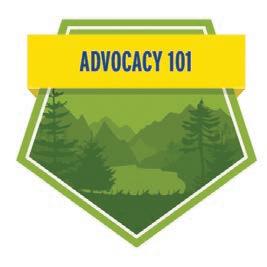
Securing policy wins can be a long game, but advocating is easy. It only takes 5-10 minutes to complete a small action that will help build momentum for important policy issues affecting the future of our public lands and climate. Whether you’re a seasoned advocate, a total newbie, or somewhere in between, Advocacy 101 will sharpen your skills regardless of your level of experience.
“I’ve seen how advocacy by outdoor enthusiasts helps achieve landmark wins for our public lands and climate. As we continue to pursue our mission during a time of growing challenges for the outdoors, it’s more important than ever for lawmakers and land managers to hear from Mountaineers,” said CEO Tom Vogl.
Constituent visits are one of the most effective ways to influence policy. Once you’ve caught your advocacy groove by taking some preliminary advocacy actions, you can take the next step by meeting with your representatives or their staff with other outdoor enthusiasts. Some of our partners, including Washington Trails Association and the Washington Wildlife and Recreation Coalition, typically organize lobby days with Washington state lawmakers. Mountaineers conservation staff and members regularly participate in these events, and we look forward to organizing similar opportunities to raise our voices for public lands and the outdoor experiences they provide.
Advocacy isn’t only about engaging your elected representatives. It’s important for land managers - federal,
As you begin your advocacy journey, we encourage you to first take the Low Impact Recreation and Public Lands 101 courses. In Low Impact Recreation, you will learn how to lessen your impact on the landscape and bolster your knowledge of Leave No Trace principles. Next, Public Lands 101 will help grow your understanding of federal public lands - an important primer before digging in on advocacy. After these courses, you'll be ready to build and flex your advocacy muscles through our new Advocacy 101 course. All these courses can be found on the conservation education page of our website and make great resources to share and integrate into any Mountaineers courses and activities you lead.
Stay tuned for timely opportunities to apply your advocacy skills in our conservation communications. In the meantime, sign up to take Advocacy 101 online at your own pace at mountaineers.org/advocacy101.
mountaineers.org 17
Take our new eLearning course to earn your Advocacy 101 badge.
MEASURING PERSONAL GROWTH ON RUTH & ICY
By Matt Dowell, two-year member

On a Friday night in late August, I headed north from Seattle with Iris, Phillip, and Jordan - three friends I’d made in the Everett Basic Climbing course. We were on our way to Ruth Mountain and Icy Peak to try what’s known as the Ruth and Icy Traverse - a linkup of two glaciated summits on the border of North Cascades National Park.
The four of us had done many trips like this over the summer. As Basic students, we’d climbed some big mountains, including Baker, Dragontail Peak, and Sahale, and made a private trip up Rainier via the DC route. This trip was different, though. There were no climb leaders to lean on and no professional guides marking the safe path. What’s more, the glaciers on Ruth and Icy were in late-season condition, with crevasses exposed or lurking under thin snow. But we wanted one more chance to use the skills we’d accumulated over the year before the climbing season ended - one more challenge to measure how far we’d come. We were unsure if attempting the traverse was wise, but after some deliberation, we committed to what I’ve come to find is the true spirit of adventure: going up in the face of uncertainty and having a look at the mountains for ourselves.
Having a look
The Basic Climbing course teaches you a lot of things. The marquee technical skills are well advertised: you’ll learn to travel safely on a glacier and to belay a leader on a rock
climb, follow them up, and rappel back down. You’ll also accumulate a number of useful skills that aren’t mentioned in the curriculum. These include strategies for hanging technical gear off your overstuffed backpack like tree ornaments, managing your caffeine addiction in the face of an alpine start, and knowing which assortment of powders and bars will keep your body fueled well past the 5,280th vertical foot it has ascended in a day.
And then there are the soft skills: teamwork, risk mitigation, and decision making. On Saturday morning around 5amwhich, at some point over the summer, had become “sleeping in” - we began the day that would put each of these skills to use. We lugged heavy packs up the trail toward Hannegan Pass, soon catching our first views of Ruth. As expected, we saw a glacier striated with exposed crevasses: an intimidating sight to be sure. But we had a lot more walking before we would have to face that obstacle, so we kept moving forward. Plenty of treats satisfied us along the way: views of the distant Chilliwacks silhouetted in wildfire smoke, Mt. Shuksan’s terrible north face on the other side of the valley, ripe trailside blueberries ready for picking. By mid-morning, we had gone as far as we could up a ridge that cleaved the north side of Ruth’s glacier. Standing on a rocky prow surrounded by ice, we used beta from past trip reports to make out the general line people had taken to the summit, but that’s where help from the outside ended.
Photo by Eddie Kruger.
(From left) Jordan Lewis, Matt Dowell, Iris Lieuw, and Phillip North, graduates of the 2023 Everett Basic Climbing course, posing in front of Icy Peak and Mt. Shuksan. Photo by Iris Lieuw.
18 mountaineer | spring 2024
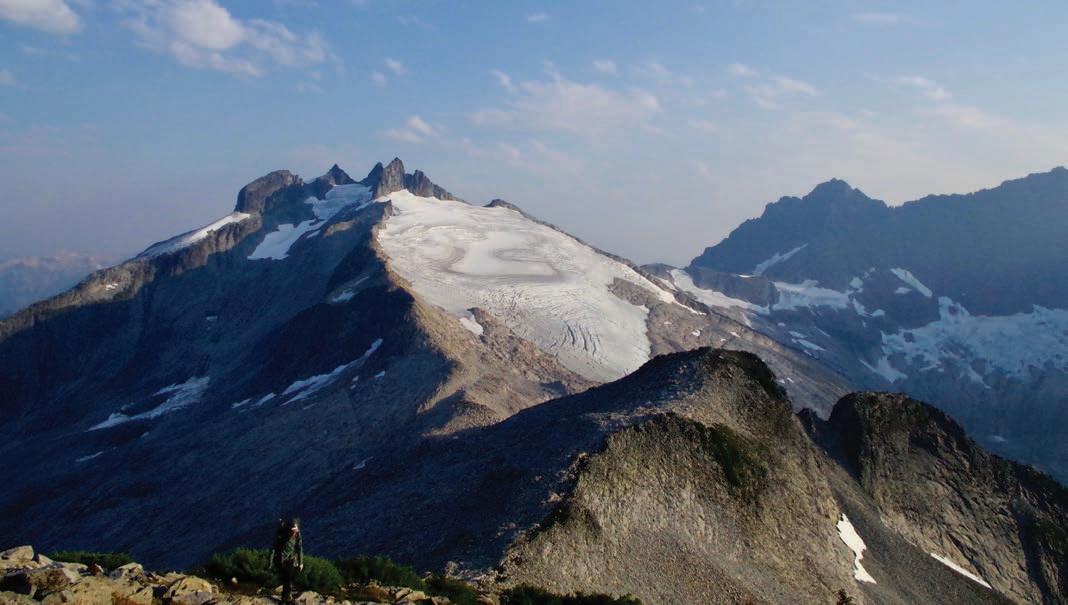

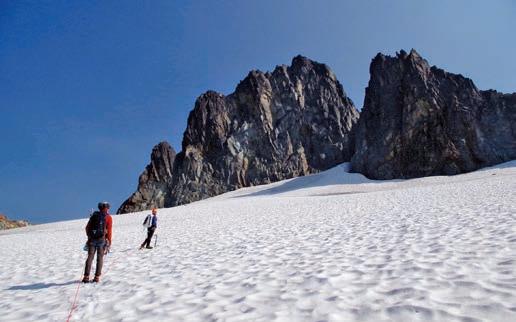
We rested and scanned the glacier. To our right lay stripes of long, parallel crevasses completely devoid of snow. To our left was a plate of exposed glacial ice that rolled over the mountainside into oblivion. The ice reflected the sun like a sheet of metal. Neither of those paths were passible. And so, half a dozen miles and a few hours into this trip, we faced the possibility that we might turn back.
A finger of unmelted snow filled a crease in the ice ahead of us. It looked to be the perfect ramp to get over the glacier’s initial hump. Stepping off the sturdy rock where we’d safely been standing would be our first brush with danger. Scanning our limited options, I felt quite aware of how remote we were.
In a moment hinting at the transcendent strength of a good team, I said something along the lines of, “Hey, I’m nervous about this.” To my relief, my teammates - who had looked so keen - said with smiling (and somehow still keen) faces, “Same!”
We sat and sipped water from a stream of glacial runoff while discussing whether to continue. Through the enumeration of facts and attempts at objective risk assessment, I kept returning to a question that my Mountaineers instructors often prompted: How am I safe?
The answer in this case was my dependable team. I had seen Iris, Phillip, and Jordan diligently practice self arrest and crevasse rescue for months during our course and was confident we would be able to halt a fall or fish each other out of most holes in the ice that might nab us. I also knew from our many conversations off the mountain that we shared a similar appetite for risk. I trusted them, and trusted our wherewithal to turn around when pressing forward no longer made sense.
Becoming acquainted with glaciers
We elected Phillip as leader and roped up. Phillip took a brave first step onto the snow finger, prodded it with his axe, kicked a
Matt, Jordan, and Iris descending Ruth Mountain. Photo by Phillip North. Jordan and Phillip ascending the glacier on Icy Peak's northwest face. Photo by Iris Lieuw.
mountaineers.org 19
Icy Peak's northwest face from Ruth Mountain. Photo by Phillip North.

20 mountaineer | spring 2024
Phillip and Matt returning to the summit of Ruth Mountain. Photo by Jordan Lewis.

step, and judged it firm enough. He continued up the five-footwide ramp between the sheets of shining ice, kicking steps and testing as he climbed. Soon, the rope became taught and Jordan started up the snow after Phillip. Then Iris was pulled on, and finally it was my turn. We were a caterpillar threading upward through the lattice of crevasses.
We made our way to the top of Ruth, and later to the top of Icy Peak. As we navigated the glaciers, I couldn’t help but reflect on their tremendous beauty. They reminded me of my smallness, both in space and time.
Though to our eyes glaciers appear frozen in place, they are in fact quite alive. Like cookie dough packed into a mountainside, their incomprehensible weight pulls them downward as they stretch and ooze along paths of least resistance. With a nudge from the underlying terrain, they climb, turn, and dive, fracture, crash, and stack up. Where the direction or steepness of their path changes, they wrinkle, crack, and break into pieces, creating crevasses so hazardous to climbers yet so orderly in their parallel rows. What weight the glaciers must bear to turn this solid ice into the viscous mass that carves mountains.
All this was new to me. I’d seen and read about glaciers over the years, but there is no substitute for the up close, tactile experience made possible through the Basic course. I had a new fondness for this terrain, a happy side effect of learning how to safely travel through it.

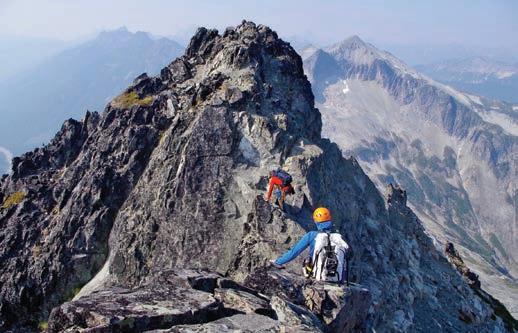
Finding joy in self-sufficiency
On top of Icy in the afternoon light, the four of us relaxed into a late lunch, perched on a spire. We filled the air with the usual chatter - lame jokes ground dull over hours on the trail. We were giddy, almost stupefied by the surrounding beauty. So far from our cars, from other people, deep into and high above this alpine scene, we felt like we were on the edge of the map. Imagine the pride we felt, having found success as we put to use all the skill, gear, and fortitude we’d been building since January. We were immensely grateful. What an opportunity this was, to travel through all the sublimity, to feel the sharp edge of the terrain. The Mountaineers makes it clear: your trip leaders are not guides. They give their time and pass on their knowledge so that you, too, might become self-sufficient in the alpine, and turn from tourist into adventurer.
We rappelled off Icy and headed back to Ruth where we would camp for the night. For our hard work and perseverance, we were rewarded with a calm, warm evening watching the sun set behind Mt. Shuksan, closing out a perfect day in the mountains, and a perfect culmination of the climbing course that had given us so much.
Phillip and Jordan descending the summit ridge on Icy Peak with Ruth Mountain in the background. Photo by Iris Lieuw.
Phillip, Matt, and Jordan resting at camp on top of Ruth Mountain. Photo by Iris Lieuw.
mountaineers.org 21
Phillip, Matt, and Jordan on the trail from Ruth Mountain with Mt. Shuksan and Mt. Baker visible. Photo by Iris Lieuw.

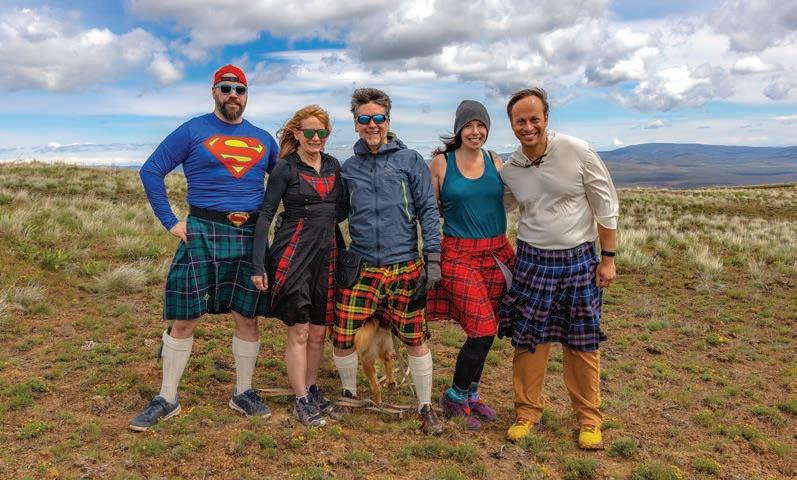

A COSTUME
CLIMBING TRADITION
Anywhere, Anytime
By Kristina Ciari, Membership & Communications Director

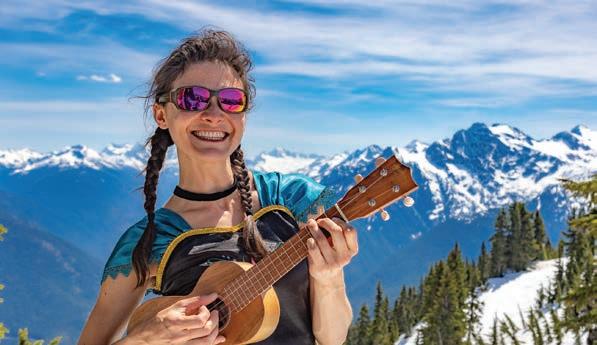
22 mountaineer | spring 2024

The sweat pours from your brow as you trudge under the spring sun, a mere half-mile from the summit. You know you’re tired, but begin to question if you’re unwell when you see not one, but a dozen people bounding toward you, clad in all kinds of hiking-inappropriate garb. One man is in a hula skirt, followed by a woman dressed as Belle from Beauty and the Beast. You sit down for safety and watch the apparitions get closer. You’re not hallucinating. You’ve just stumbled upon the elusive Mother’s Day hikers outside of their usual haunt.
One of the Pacific Northwest’s grand traditions - a right of passage for many aspiring mountaineers - is climbing Mt. St. Helens, in a dress, on Mother’s Day. Inspired by the famous 1987 red dress of Kathy Phibbs, photographed and featured on the cover of the Seattle Times, thousands of aspiring summiteers flock to the flanks of Helens each May, donning their Sunday best. But as the tradition has grown and permits have become more restricted, many are taking their dressgame elsewhere.
Enter: Mushtaque Silat, dress-hiking enthusiast and annual organizer of the anywhere-but-Helens Mother’s Day dress tradition.
“My hiking career started back in 2009,” said Mushtaque, who one day hopes to explore more of the mountains in his homeland of Pakistan. “I was just following all the Washington Trails Association (WTA) hikes and finally got to a point where I needed something more challenging. I joined The
Mountaineers in 2015 and took the scrambling course. I got to learn a lot of new skills and get comfortable in the snow. I took the glacier travel class and was able to climb the Washington five volcanoes.”
One of those volcanoes was Mt. St. Helens on Mother’s Day weekend, a tradition Mushtaque and his crew took part in with great enthusiasm. But after a few years, crowds got bigger and permits became harder to come by. Plus, they’d seen Helens already.
“There are so many mountains out there - why not try something else,” said Martina Kohlus, a 7-year Mountaineers member, and regular participant in the dress-donning tradition. So explore they did. To train and have regular touch points with the community, Mushtaque began organizing weekly sunset hikes in the Snoqualmie region. A highly international crew shows up each week, with the training regimen helping to ready folks for the annual dress-climb the weekend before Mother’s Day.
The location is selected based on the whims of the weather. One year, the group had to bail on a trip to Ruth Mountain to instead go to Umtanum Ridge because of an atmospheric river. No matter, they shared a fun day and surprised casual day hikers with their spirited attire and spirited celebrations.
As for a dress code? “Not everybody shows up in a dress, but everyone dresses up,” said Mushtaque. “It’s a really multicultural crew with a lot of people from India, so they wear
mountaineers.org 23
Left page, clockwise from top left: Tracy Brigham (the co-organizer) on Sourdough Mountain, May 2019. All photos by Mushtaque Silat. The Kilt Climbers on Umtanum Ridge, May 2022. Kavita Kamani donning a traditional shawl on Sourdough Mountain, May 2019. Eva Szalewicz (the group musician) providing summit entertainment on Icicle Ridge, May 2021. Joyous coordinated posing on Umtanum Ridge, May 2022. Above: The dress climbers on Mt. St. Helens, May 2018.
“I finally figured out the only reason to be alive is to enjoy it.”
–Rita Mae Brown
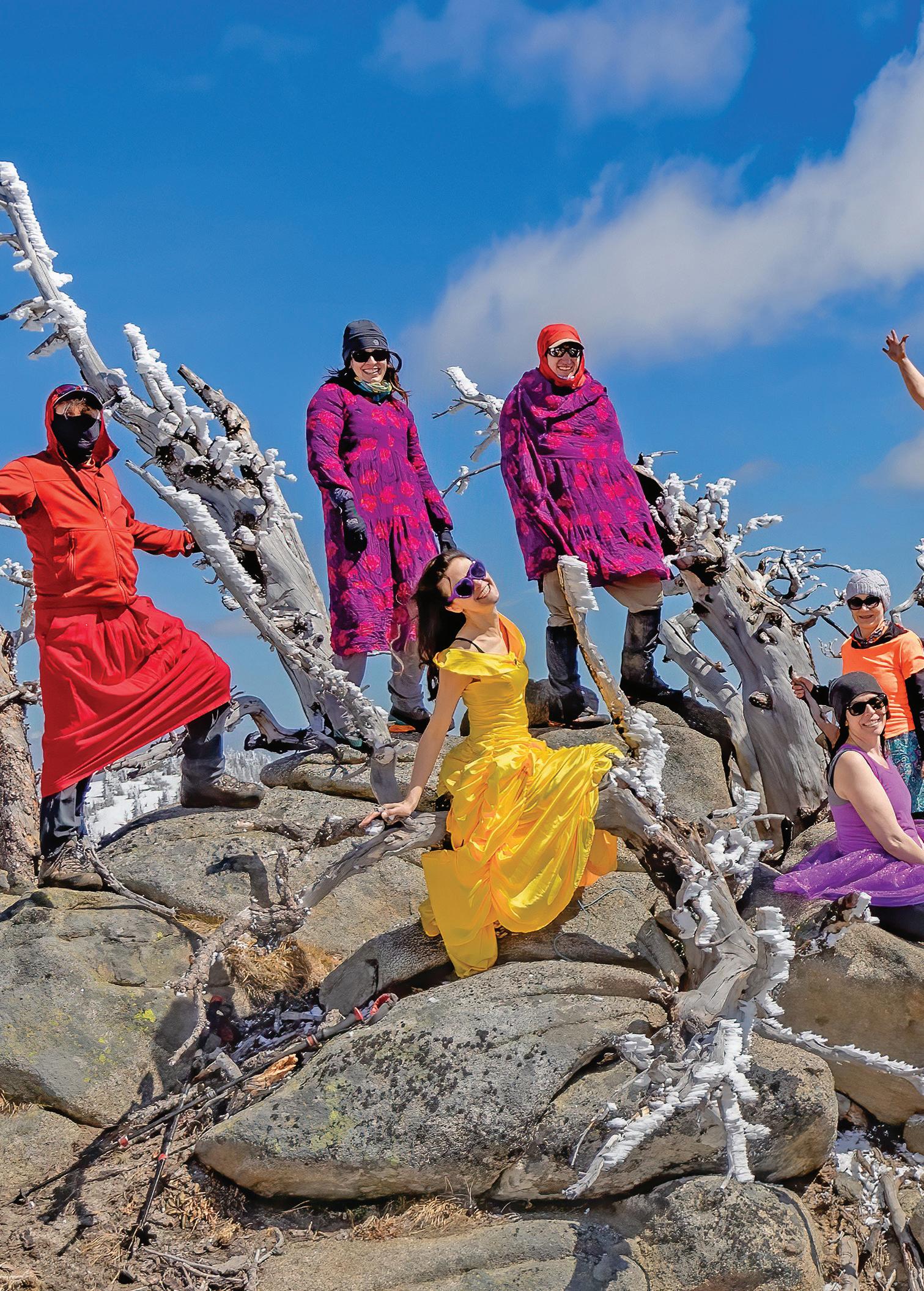
24 mountaineer | spring 2024

25
The dress climbers on Icicle Ridge, May 2021. Photo by Mushtaque Silat. mountaineers.org


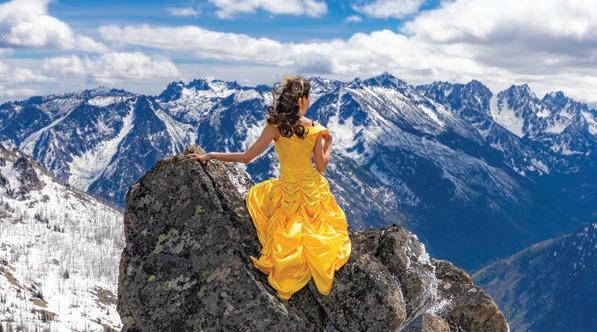
Saris. Other people wear kilts. I've worn my wife's dresses that she's discarded. It really depends on what people are comfortable with.”
“I’m not really a dress person,” said Lindsay Fincher, tenyear Mountaineers member and reluctant dress-hiker. “I was digging through my closet one year and I found this dress that I’d bought for a job many years ago where we had to put on this formal conference. I really hated that job. My boss was an awful person. But when I was digging through my closet, I was thinking that I wanted to take this dress that held bad memories and turn it into something awesome.”
The tradition is fun for onlookers too. “People definitely notice you,” said Mushtaque. “They want to take our picture and celebrate with us.” Sometimes folks join in their summit celebrations. Mushtaque always plans for a few hours at each summit so folks can share food, dance, sing, take goofy pictures, and listen to memorable ukulele performances by Eva Agnieszka Szalewicz, who the group lovingly refers to as “our musician.”
When I asked why this has become such an important tradition, the answer came as no surprise. “We all have our lives - our very busy lives,” said Martina, who grew up in big cities in Germany and the Czech Republic and never thought of herself as a mountain person before moving to the PNW. “Some of those people I don’t get to see unless I go to those hikes. It’s a great opportunity for all of us to come together and just enjoy ourselves.”
“These trips are a really nice day to see a lot of people you don’t normally get to see,” said Lindsay. “One of my favorite hikes was in 2021. We did Icicle Ridge in Leavenworth, and at that point, COVID was going on and everyone was finally able to get vaccinated. A lot of us hadn’t seen each other for a year or so. The time away made our experience together all the more special.”
“Every year I am able to attend is unique in its own way,” said Martina. “It’s not about the climb itself, it’s just about being together.”
26 mountaineer | spring 2024
Clockwise from top left: The dress climbers on Sourdough Mountain, May 2019. Eva Szalewicz in her Belle costume on Icicle Ridge, May 2021. Tracy and Tony doing their favorite pose on Icicle Ridge, May 2021.
Going Home to a Place I’d Never Been
By Raymond B. Huey, 28-year member
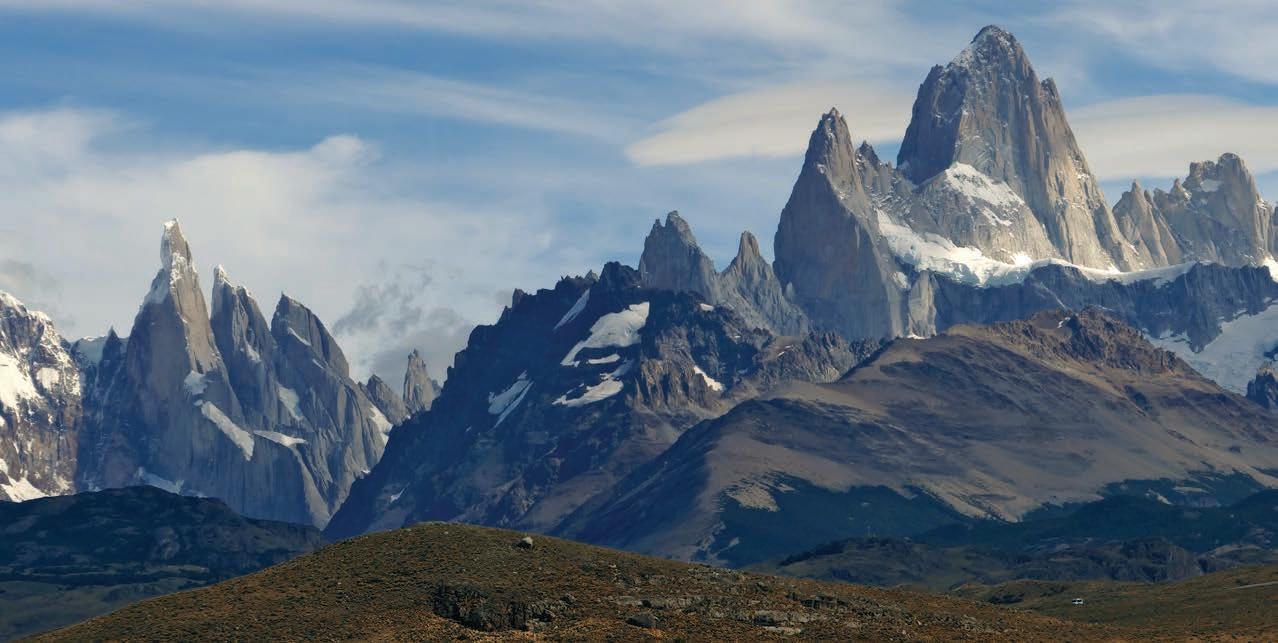
In 2019, I joined a Global Adventures trip – first to Torres del Paine in Chile and then to the Fitz Roy Massif in Argentina. I was 76 and rather long in the tooth for a backpack classified as “very strenuous.” But Fitz Roy was a mountain I’d wanted to see since my late teens. This was my first chance. Jump!
Fitz Roy entered my life when I was in early college. I’d grown up hiking and scrambling in the Sierras and San Jacintos in California and devouring mountaineering books. Among my favorites was Maurice Herzog’s Annapurna, the story of the first ascent of an 8,000m peak. In 1964, I learned that Lionel Terray (a key member of the Annapurna team) was giving a lecture at the American Alpine Club in Los Angeles. I took the light rail from Long Beach to hear him.
Terray was physically imposing: his shoulders appeared almost as wide as he was tall. He showed films of his pioneering climbs, including the first ascent of Fitz Roy in 1952. I was stunned by one photograph he shared of the stark, beautiful peak. The image imprinted on my brain - I knew it was a mountain I needed to see in person.
But college, grad school, and academia intervened. I stopped hiking and reading about mountaineering. Even Fitz Roy rarely entered my thoughts. Just before retiring in 2014, I realized I needed to revisit mountains and trails. Backpacking had evolved since my teens, so to catch up I took The Mountaineers Backpacking Building Blocks course run by Cheryl Talbert. Then in 2018, Cheryl told me about a Global Adventures trip she was organizing to Torres del Paine and the Fitz Roy Massif. I knew had to go.
I didn’t expect to see Fitz Roy until after we finished our trek to Torres del Paine. But as we flew over the South Patagonian Icefield, I looked to the east and saw a row of rugged peaks: Fitz Roy, Cerro Torre, and their pointy friends. It was not a view I’d ever seen. Terray’s photograph – and all others I’d seen over the decades – were taken looking west, but even
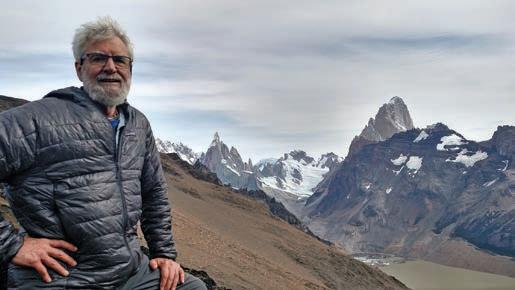
from its "backside," Fitz Roy’s silhouette was unmistakable and magnificent. I teared with surprise and excitement.
After we finished the O-circuit of Torres del Paine (itself as wonderful as advertised), we bused to Argentina. Suddenly, Fitz Roy loomed in the far distance. Cheryl stopped our bus. We piled out and marveled at the peak. Almost 54 years had elapsed since I’d first seen Terray’s photo. I teared again. We spent a magical week backpacking around the Massif. I immediately felt at home there and was delighted to share this adventure with other Mountaineers, our guides, and the mountains. We saw stunning sunrises and sunsets, used ziplines to cross rivers, found fossils, and experienced the notorious Patagonian winds.
Before dawn on our second day, we climbed the steep moraine to a “mirador” (overlook) just below Fitz Roy, wandered past the reflection lakes below, and watched the sunrise turn the peaks and snowfields vivid orange. I could see the route that Terray might have taken to the base of Fitz Roy’s face many decades before. I felt privileged to walk in his footsteps even for a little while.
I was lucky to still be fit enough to make this long-desired trip, and I’m grateful to Cheryl and The Mountaineers for making this dream come true. Most importantly, I learned that you can go home again, even to a place where you have never been before. I realized Fitz Roy had been home for most of my life.
Ray enjoying Fitz Roy.
Photo by Cheryl Talbert.
mountaineers.org 27
globaladventures
The Fitz Roy Massif (right) and Cerro del Torre (left). Photo by Raymond Huey.
HUMILITY IN TIME
Thinking Like a Glacier in the Sinlahekin Valley
By Thomas Bancroft, Naturalist Leader and Super Volunteer

North, the hill plunges over 600 feet. South, it drops a similar elevation in increments. The hilltop is maybe a hundred feet wide, flat, and stretches a hundred yards or more perpendicular to the valley’s western wall before descending in stair steps to the creek running north. My mind tries to comprehend time and what has happened to sculpt the amazing configuration of this valley.
Five Mountaineers friends have accompanied me to the Sinlahekin Valley in northcentral Washington to look for birds, flowers, trees, and butterflies, and to try to comprehend this landscape’s geological history. We are standing on a terminal moraine where, incredibly, the sand and gravel wall is deep enough to bury Seattle’s Space Needle.
Before we begin our hike, I pose a question to the group while kicking the dirt mixture under our feet. “I give you a hundred people, all with shovels. How long will it take your crew to cover the Space Needle with sand and gravel?”
They all stare at me like I am crazy. “This mound was laid down by a Pleistocene glacier that sat just over there,” I say, pointing to the north of the moraine’s wall. “I don’t know for how long - a century, a thousand years, maybe two.”
These large, terminal moraines form when a glacier sits in one spot for a long time, moving forward at about the same speed it melts. Any rock, gravel, or sand in the ice, on its top, or dragged along is dumped at the glacier’s end, like
a conveyor belt dropping wheat into a silo. The look of bewilderment on their faces is beautiful as they imagine how long it would take to do a glacier’s work. They, too, are trying to understand time and what it means.
I’d been to this valley three times before I knew about the terminal moraine. Embarrassing, but I tell this fact to the group anyway. I’d birded along Sinlahekin Creek and identified wildflowers, but never had an inkling that 15 to 20 millennia ago, a glacier had consumed this valley. A few years ago, I searched for geologic information on the Okanogan and discovered this spot was one of the best examples of a terminal moraine in Washington. A side lobe from the Cordilleran Ice Sheet used to extend down this valley, gradually pulling back until it reached where we now stand. It sat for a long time before retreating rapidly. What else was I missing?
The language of the land
One of the fun things about organizing Mountaineers trips is the people that come along with their unique ways of looking at the world. This morning’s hike is enjoyable. I’ve done it several times, but see much more today because of all the eyes. We haven’t gone a quarter mile, and already encounter a large patch of Lewis flax. The blue flowers lazily sway in the light breeze. Their petals glisten in the filtered light. This member of Linaceae is native and widespread across North America.
28 mountaineer | spring 2024
Atop Cecil Creek Moraine, looking south across the Sinlahekin Valley. All photos by Thomas Bancroft.
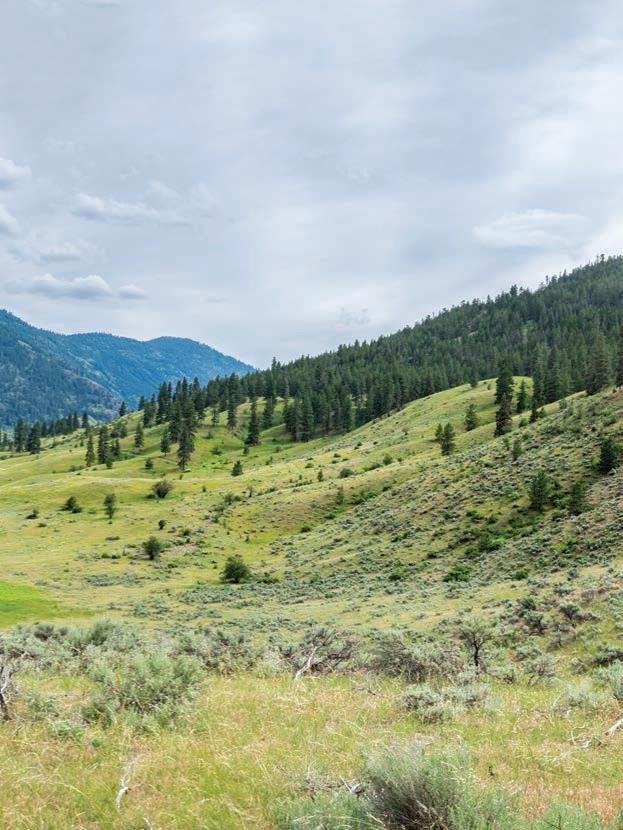
Someone says, “Admiral,” and a three-inch butterfly with black, white, and reddish-tan wings flutters out of the flower patch to land on the sandy track. We cluster around it. Lewis flax is a perennial that blooms in June for a half-dozen or so years, while the adult Admiral butterfly lives for only a few weeks after it emerges from its chrysalis, just long enough to find a mate and lay eggs for the next generation. I look down at my feet, thinking about how I’ve just started my eighth decade.
What is it about time and how we think?
The group starts moseying down the track. A large mound rises a quarter mile further on the left, about 20 to 30 feet tall. Grasses and Ponderosa pines grow on its slope and top. The pines might be several centuries old, and the grasses are long-lived perennials, too. But that knoll is what I want us to contemplate. I've yet to find any geologic details on these mounds scattered along the valley, but my guess is that if we bore into them, we’d find they were composed of sand, small gravel, and no bedrock. Someone says, “Probably from a glacier.”
I don’t pretend to be a geologic expert, and all my compatriots have read about the geology of Washington. I suggest these mounds might either be drumlins or eskers. Both are formed by the interaction of meltwater and ice. Eskers tend to be long, thin ridges where a stream flows under the ice, gradually depositing sediments. Drumlins are also formed by

subglacial waterways, either through deposition or erosion. Someone notes that drumlins tend to have a fan base in the direction of flow. We point at the terrain, thinking we see the fan. Someone else says these might have been created when pressurized water shot from under the ice like a giant fire hose, taking with it any sediments. Either way, we’re standing where a thick ice sheet would have risen above us some 20,000 years ago. Might we still be feeling the weight of that ice on our shoulders?
Hummingbirds and mountains
“Hummingbird,” comes from behind me and I hurry to the group. “It looks tiny, maybe a Calliope,” someone says. The bird sits on the extreme top of a willow along the creek. We creep through the grass to have a closer look. Calliopes are the smallest bird in the United States, about half the size of the incredibly small Bushtit. Males average between 2.3 and 2.7 grams, depending on where and when they are measured. A little over half a teaspoon of sugar weighs a similar amount. To me, these Calliope Hummingbirds seem like flying bumblebees more than birds.
Time is an enigma. According to Birds of the World, the oldest Calliope Hummingbirds were two females recaptured six years after banding. Most who reach breeding age, though, only have one or two summers to reproduce. Incredibly, these little birds also have a monumental migration route. In late
mountaineers.org 29
Wooly Mullein.
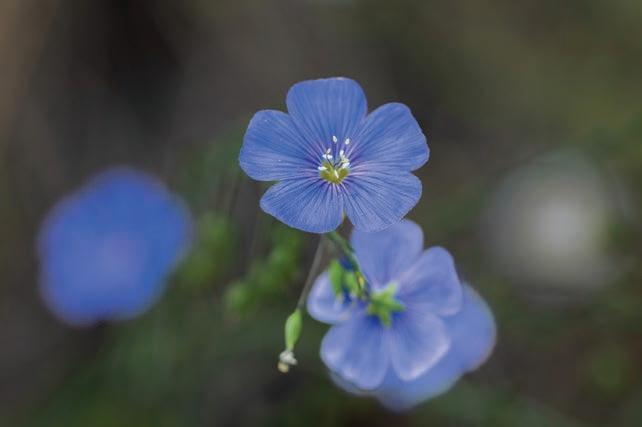
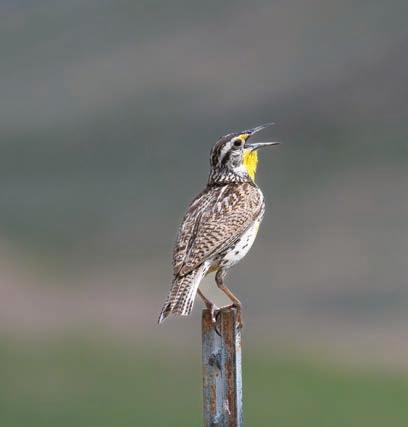


summer, they head south through the Rocky Mountains to winter in southern Mexico, and in the spring they come north through the Sierras and the Cascades. Both trips are timed to catch flowers whose nectar fuels their efforts. To think, a living thing that weighs only half a teaspoon of sugar can fly two to five thousand miles on its fall and spring jaunts. Sure, they don’t do it all at once, but over several weeks or months, stopping to feed along the way. Still, I’d never make it that far in those time frames.
Thirty minutes later, I climb a knoll covered with Ponderosa pines and turn to look. My group is divided in two. A quarter mile back, three people cluster around some flowers. They’re looking at a butterfly, I guess, by how they point. Two others kneel with their field guides, checking a flower. I look back and forth at the knoll where I stand. This rise is different from the previous one: more perpendicular to the valley and with a similar bulge from the other side of the creek. Maybe this is a small moraine where the glacier only sat briefly, or perhaps pulled back and pushed forward, plowing up this mound. The creek may have carved through it after the ice left.
The valley here grabs my attention. Glaciers shaped this land 10s of millennia ago, but the valley formation itself is much older, shaped 100s of millions of years ago (MYA). Twohundred MYA, the west coast of North America was east of here, near Spokane, Washington. Over the next several 10s of MYA, the Pacific Crust and the islands on it didn’t subduct under the North American Plate with continental drift but rather accreted to it, extending the coastline west. The underlying rocks here are part of the Intermontane Belt, the terrane that accreted during the Jurassic. Still, this valley was influenced by the next terrane, the Insular Belt, that arrived with continental drift. Starting in the middle of the Cretaceous, about 130 MYA, the Insular Belt began to accrete, forming the North Cascades. The collision and subduction caused magma to rise into the Intermontane Belt, forming the Okanogan Highlands. Large volcanos grew, uplifting the metamorphic rocks of the Intermontane. At some point, some of those metamorphic rocks slid off the top and to the west. The valley’s walls in the Sinlahekin are parts of those slides. These cliffs are tall, rising several thousand
30 mountaineer | spring 2024
Lewis Flax.
Western Meadowlark.
Yellow-breasted Chat.
Glacial till along the edge of an esker.




feet, almost vertically. They were once twenty or more miles east of where we stand before they slid down. I found nothing that says how fast they slid; maybe it took millions of years. It is mind-boggling. Everything looks solid, unchanging in our lifespan.
Cherishing time
Our hike takes longer than expected. It is only four miles, but at 1pm we still have a half-mile to go, and we’ve been at it for more than four hours. Worse, I had told everyone they didn’t need to bring their lunch. That’s a naturalist hike for you; so many things to study. We measure our trips in hours per mile, rather than the reverse. There is time again. I recall a saying by Hermann Hesse, “Little joys.”
I look down from a small ridge. Two from our group are entering a quaking aspen grove. The clump of trees extends for several acres, hundreds of trunks rising into the sky, their small greenish-yellow leaves fluttering in the light breeze. Aspens reproduce readily by sprouting from their root system. Sometimes these groves are clones of a single individual tree,
making them all genetically identical. I raise my binoculars to study the forest, marveling at the ripple of leaves. Generally, a single trunk only lives up to 150 years, but the grove can commonly be 10,000 years old. One grove in Utah is estimated to be 80,000 years old. For a living organism, this seems almost immortal. Perhaps this grove started soon after the ice pulled back and has lived here ever since. These trees make me think of my granddaughter, only two months old. How much of her life will I be part of? Might I be blessed to see her graduate high school or college? At 71 now, every minute is special.
“Chipping Sparrow,” someone calls, bringing my attention back to the dappled light of some conifers. Two young birds perch in a Douglas fir. Their plumage shows they have just hatched this summer. They look at us, then flick down the hill to the north into the forest. Hermann Hesse would have told us to cherish every second of this day and would have complimented us on never hurrying.
mountaineers.org 31
Mountaineers marveling at the natural world.
Common Wood Nymph.
Eastern Kingbird.
The Sinlahekin Valley.
THE BIG CALL
Conversations With Big Snow Mountain
By Nick Aadland, nature photographer
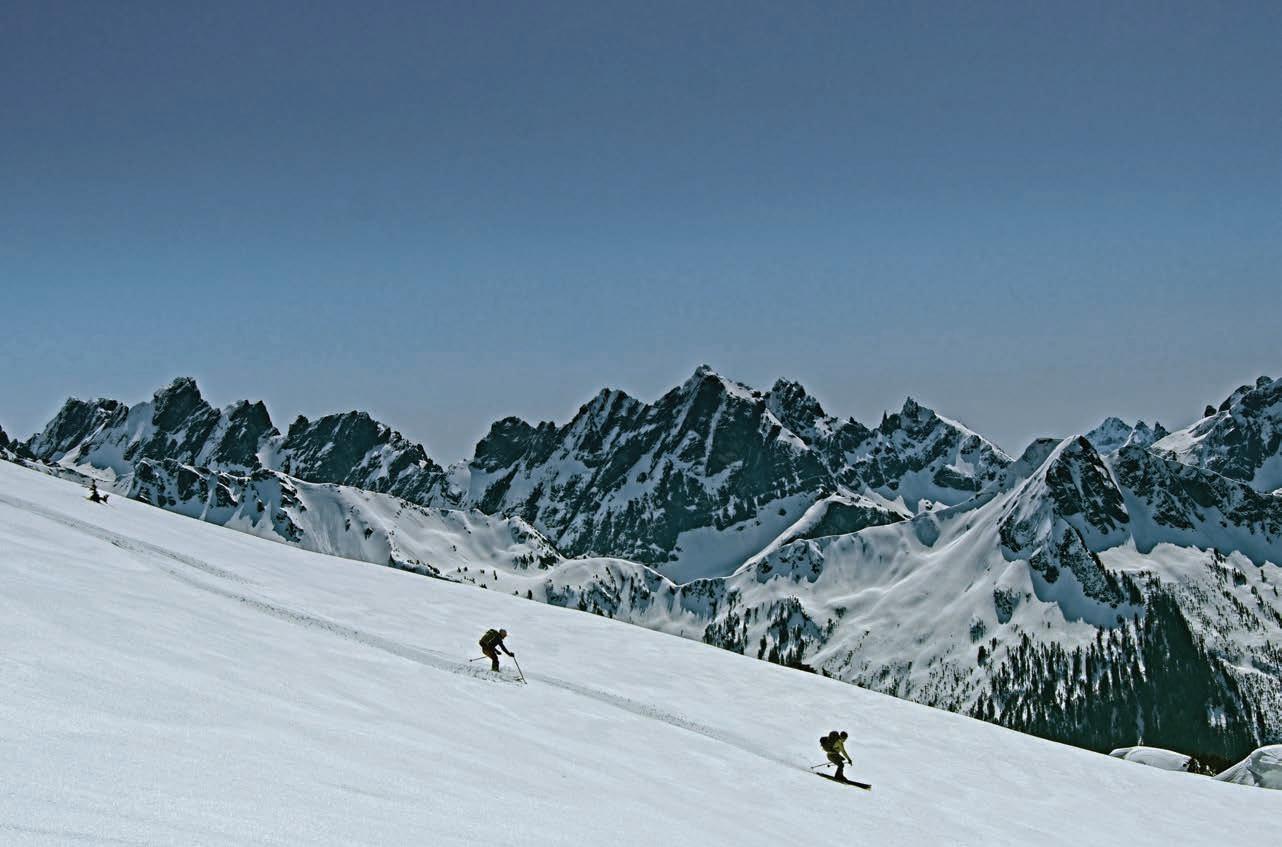
Squinting against the morning sun, I stab my pole into the steep east face of Wild Goat Peak and break loose a small snowball that quickly grows to the size of a man’s torso. Gaining speed as it travels downhill, the snowball finally topples where the mountain’s pitch shallows out. The test confirms my suspicions: this face is ripe for a wet avalanche.
Nervously, I survey the landscape ahead. Our route takes us across a few continuously steep pitches, all with cliff bands looming dangerously below. Every step out on the face will kick more snowballs, inevitably triggering a large slide. In all likelihood, the slide would run out below us, leaving us watching thousands of pounds of heavy snow cascading down the cliffs. But one slip and we could easily get caught and dragged down, too. All it would take is one snowball to fall off a rock or tree above and trigger a slide, and we would have no escape. I look back at my ski partner Tom. His face is telling me the same thing as Wild Goat Peak. Sometimes the dream isn’t worth a nightmare.
The plan
Five weeks ago, Kyle, Tom, and I had set our sights on the Snoqualmie Haute Route. Pioneered by Martin Volken in 2000 and named after the world-famous Haute Route in France and Switzerland, the route traverses the towering crest northeast of Snoqualmie Pass. I like to call it the “Snoqualmie Crest.”
It’s made of jagged spires, sheer walls, and hanging glaciers. The peaks are so dense that they are named in groups. The Chiefs. The Chimneys. The Lemahs. They’re hard to see from any road, yet hard to miss from any peak.
I’ve spent years branching out from the ski area into the backcountry ski terrain around Snoqualmie Pass. With at least a full day approach from any direction, and surrounded by other worthy objectives, the Snoqualmie Haute Route explores a zone I have often seen and seldom visited. It’s my favorite part of the Cascades.
After a tumultuous early spring, we’re ecstatic when a highpressure system develops, forecasting sunshine all five days. Unfortunately, the snowpack needs time to transition from winter to spring. Avalanche conditions can be dangerous as the snow warms until it settles from repeated freeze-thaw cycles. The forecast predicts an increase in temperature each day, and above freezing temperatures each night, meaning the snow would be continuously transitioning throughout the trip. We pack extra sunscreen and promise to be careful.
The pull
Our journey starts deep in the Middle Fork Snoqualmie drainage and slowly earns peekaboo views of the northwest face of our day’s summit objective: Big Snow Mountain. We have no plans to ski anything I can see so far, but my mind is trained to seek skiable lines. The northwest face is an
32 mountaineer | spring 2024
Tom and Kyle teasing the south faces of Big Snow Mountain. All photos by Nick Aadland.


easy one to read. It’s cut straight down the middle by a deep gully directly below an obvious weakness in the otherwise impassible cliffs guarding both sides. I name it “The Crack,” in a simplistic ode to the popular line “The Slot” on nearby Snoqualmie Mountain, take some pictures, and file it away in my ever-growing mental list of places I want to ski one day.
One steep boot pack and the character of the landscape drastically changes. We exit the forest and abruptly enter the subalpine. The broad and complex north face of Big Snow Mountain glistens before us – a Pacific Northwest masterpiece: two frozen lakes flanked by isolated rock towers, steep couloirs, wide open bowls, waterfalls, and ice flows. Unlike the obvious single line of the northwest face, the north face of Big Snow is a cornucopia of skiing potential. Of the countless options, one line holds me particularly transfixed. Centered over the lower lake, the steep, continuous fall line runs from a shoulder just shy of the summit, weaving delicately through cliff bands, narrowing into a tight couloir lined by a huge cliff, and ending in an apron on the frozen lake. I name it “The Centerpiece” and file it away with the others.
During a quick lunch, I enjoy mind-surfing that face before our itinerary forces us on. The summit view is incredible, surpassing even my high expectations. No longer playing with theoreticals, we can now see our entire intended route through the heart of the Snoqualmie Crest. With the day’s


climbing complete, we stay longer than we should at the summit, and watch as the sun paints the mountains pink. Our descent will be challenging in the cooling snow, but it’s hard to tear our eyes away from the glorious terrain we’ll enjoy over the next four days.
Although headed east, our route down takes us across the north shoulder and directly over “The Centerpiece” I’d seen from lunch. It’s one thing to admire a line from below, quite another to be perfectly positioned to drop in. I pause to look down at the lake below. I feel the pull of the line, the anticipation, despite the fact that we’re skiing past it onto the broad benches of the northeast face toward Gold Lake. No time for that today.
The race
We rise with the sun and climb the shadowy west slopes, still hard and icy despite warm overnight temperatures. The snow is hard enough that we need ski crampons to hold an edge as the slope steepens. While firm snow makes the climb more dangerous, it means the snow is transitioning to spring conditions. On the other side of the ridge, the sun is warming the snow, and if our timing is right, we’ll be rewarded with great skiing.
Everything is going according to plan until I lose one of my ski crampons on the final approach to the ridge. I watch it bounce, spin, and pick up speed as it careens toward the cliff band we’ve just finished climbing around. Powerful sunshine
mountaineers.org 33
Clockwise from top left: The North Slopes of Big Snow Mountain, a Pacific Northwest Masterpiece. "The Crack," begging to be skied." Tom among views of The Lemahs. Kyle enjoying camp life.

is already baking the snow, and if we wait too long it could be dangerously soft. I write the crampon off as gone before it even goes out of sight. We don’t have time for a low-probability rescue mission for an $80 piece of gear. The mountains giveth, and the mountains taketh away.
And that’s how I find myself standing on the fateful east face of Wild Goat Peak, watching as a snowball turns into a torso with the flick of a ski pole. We’re already too late.
The turn
One of my favorite sayings is, “Take what the mountains give you.” The message offers important wisdom about being observant and flexible with your own plans. But I like to think about it as a two-way conversation. The mountains have a will too, with their own desires and opinions. It’s easier for me to follow nature’s directions when I imagine I’m meant to hear them. I swear the mountains are trying to trick me sometimes, but I do my best to study the terrain before going out; I watch for signs and signals while I’m in their presence, and I listen to the wisdom that is shared, even if I don’t always understand it. If I’m lucky, the mountains speak, and I hear. If I’m even luckier, my plan gets thrown out the window and I find the path that’s meant for me.
We discuss the many alternatives to traversing the bright, mushy, and exposed east face. A safer route would be to back-
track through last night’s camp. From there we could drop lower into the valleys, but lower elevations might not have refrozen and may be worse. The hot forecast guarantees we’ll be making similar hard decisions throughout the next four days. We could race the sun to each slope, which would require an early headlamp start each morning and might not even be possible. Still, that doesn’t solve today’s problem.
Our brains churn, doing mental gymnastics to figure out a way to win a race we’ve already lost. The Snoqualmie Crest taunts us, casting huge shadows into the deep valley separating us from our destination. I turn my back to the sun in frustration and look back on Big Snow. Yesterday’s tracks trace an easy climb back up to the north shoulder. Bathed in morning light, they look like a golden staircase.
My mind wanders back to “The Centerpiece” and the pull I’d felt the day before. “We could spend five days skiing Big Snow instead,” I offer, breaking our contemplative silence.
I’m half kidding. One line isn’t enough to keep us busy for four more days, but the idea has merit. Big Snow is huge, complex, and diverse. With skiable faces on every aspect, we could pick our lines like the hands of a clock and hit each one at just the right moment as the snow ripens in the sun. Establishing a base camp there means we wouldn’t need to carry our overnight gear and food each day. We wouldn’t get to travel the famous Snoqualmie Crest, but we would enjoy its view
34 mountaineer | spring 2024
Tom, Kyle, and The Chiefs.
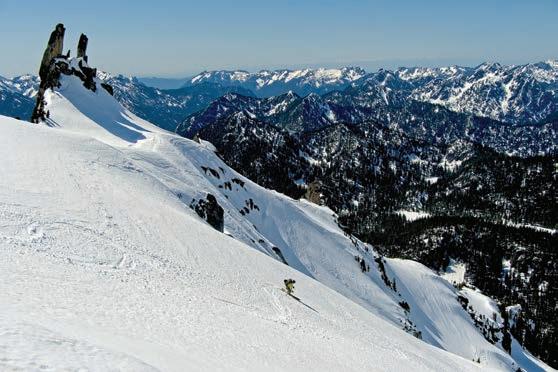

every day. It’s the best plan anyone has put forward so far. It gives us an immediate reward and puts us closer to a viable exit. That was enough to sway the group. We turn our backs on a dream and accept the simple suggestion.
The dance
We retrace our previous day’s route and head directly for “The Centerpiece.” Our retreat is immediately rewarded by the miraculous recovery of my lost ski crampon. It had deftly navigated many trees and holes of the cliff band and was patiently waiting for me on the flats below. Even though I don’t need it for our climb up the golden staircase, I’m glad to have it back.
In our naivety, we drop before the sun has had a chance to say hello to this side of the peak. We scrape and skitter through an exciting but icy descent. Over time we become acquainted with the entire mountain, learning its shape and rhythm. We’re rewarded with great lines on every aspect. We grow intimately familiar with the skin track from camp to the north summit ridge, meticulously manicuring it in the soft evenings to facilitate easier travel in the crusty mornings. We tease the south faces as the sun rises and retreat quickly when the corn gives way to isothermal glop.
We repeat “The Centerpiece” a different day, this time after the sun has reached all but the deepest folds of the lower

couloir. Our evenings are spent watching the mountain light up in pink and gold, highlighting the visible memories our tracks have painted as we make plans for more. We end the trip in perfect symmetry, using “The Crack” we’d spotted on our way in as our exit.
There will always be more to experience than is possible to accomplish in a single lifetime, much less five days. Amid a sea of mountains I’d dreamed of exploring, I spend an entire trip on just one. When we made the decision to turn around, I had been dubious that we would stay at Big Snow Mountain for the full five days, imagining it rather as a short-lived consolation prize. But Big Snow Mountain changed my mind.
I love backcountry skiing because of the freedom of movement it grants me through terrain. The more time I spend in the mountains, the more possibilities I see and the more difficult it gets to decide which possibilities to pursue. Spotting a good line is about reading terrain. Choosing a line is about reading conditions. In the delicate balance between freedom and constraint, it’s all too easy to let our ego be louder than the mountain’s whispers. There is art in finding joy in the conversation.
mountaineers.org 35
Clockwise from top left: We pick our lines like the hands of a clock. Burnt Boot: One of many dream lines added to the ever growing list. The Snoqualmie Crest taunts us before we decide to remain on Big Snow Mountain.
Oh to Live on Bear Mountain
By Craig Romano, Mountaineers Books Guidebook Author
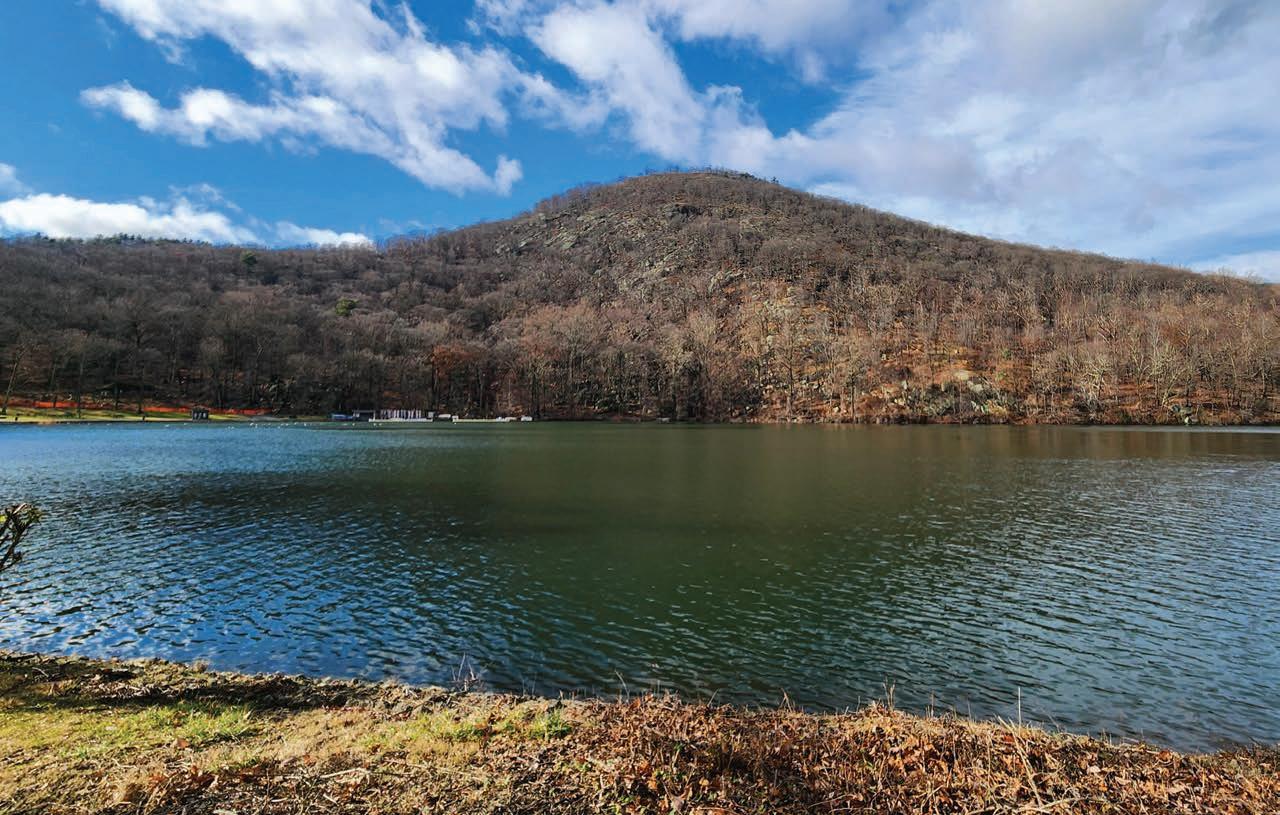
Iwasn’t born into a family of hikers or a lineage of outdoorspeople. I was born in Bridgeport, Connecticut — a largely industrial, multi-ethnic city on Long Island Sound in the greater New York City Metropolitan Area. My neighborhood consisted of two and three family homes in the city’s Little Italy north end. Bridgeport, which had once attracted waves of immigrants, began its decline in the late 60s, prompting thousands to leave for the suburbs. We would eventually leave too, and to a place less disconnected from nature; but living in a dense metropolis didn’t stop me from discovering my love for wild places.
Finding myself at Bear Mountain
In my parent’s busy schedule of trying to fulfill the American dream, they etched out time for occasional trips to the countryside. One of the places we went to several times was New York’s Bear Mountain State Park. Sixty-five miles from Bridgeport (and a mere hour north of Manhattan) it felt hundreds of miles away. The ride there transitioned from city after city of urban sprawl to a magical land of low, rolling forested mountains lining the shores of the Hudson River. These same settings inspired famed landscape artist Thomas Cole and his Hudson River School.
Crossing the Hudson, high on the elegant 1924-built Bear Mountain Bridge (the largest suspension bridge in the world at its opening), and into the park was like entering a portal into the wilderness. The mountain’s name alone fascinated
me. Bears must live here, I pondered (they do). It was at once frightening and thrilling.
Bear Mountain was the first place I learned about the Appalachian Trail. My family would walk a mile or so on it heading to the Civilian Conservation Corps-built tower on the mountain’s summit. At the time, I thought I was as deep in the wilderness as it gets. And, being a young child who had only experienced Bridgeport, I was! I couldn’t believe people hiked this trail in its entirety (back then, a lot fewer did). It was unfathomable.
It became apparent to me that I did not want to live in a world without Bear Mountain, nature, wilderness, and wildlife. After bonding with the outdoors, I wanted to live a life centered on the natural world. The city, with all its promises (and noise, crowds, pollution, and pavement), didn’t appeal to me. I wanted to be on Bear Mountain, and someday explore more of the Appalachian Trail that winds over hundreds of natural places with their own Bear Mountains.
Awakening the wilderness gene
Ecologist Dave Forman wrote of the small percentage of us who are born with the “wilderness gene.” He posited that no shared experience enlightens us to revere the natural world — that some people just get it. But I believe this “wilderness gene” lies dormant in all of us, just waiting to be stimulated. At no time did I want to pursue a life in the city, keep up with the Jones, and race with the rats. I wanted to be in nature,
36 mountaineer | spring 2024 trailtalk
Bear Mountain and Hessian Lake. All photos by Craig Romano.

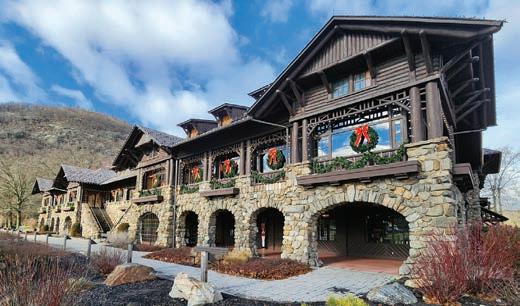
a world that makes more sense to me, a place that brings me satisfaction, self-acceptance, and spiritual connection. I’m convinced there are more children out there with the wilderness gene who aren’t yet aware of their condition.
In our urbanized and digital world, fueled by anxiety and environmental degradation, it is imperative that we help these children reach self-actualization. It has never been more important to expose our children to the natural world with all its beauty, wonderment, and rejuvenating qualities, for their sake and the planet’s.
Conduiting a love for wild places
It didn’t take a trip to Yellowstone, the Grand Canyon, or Mt. Rainier to stimulate my wilderness gene. My love for the wilderness was awoken by traveling to a place not too far from home. Yet Bear Mountain, in many respects, is like our crown jewel national parks; places where nature has been allowed to flourish, and visitors allowed to explore and experience it. Young children don’t need sweeping views and superlative beauty in order to be moved. A Mt. Rainier, Yosemite, or Zion isn’t necessary to bond them to nature. For a child in the Bronx, a trip up the Hudson to Bear Mountain can be just as exciting as a visit to Mt. Rainier for a child from Seattle. But in all circumstances, there needs to be a conduit — someone who introduces that child to the natural world.
The urban drabness of Bridgeport didn’t introduce me to the woods nor plant in me the seeds of outdoor discovery. That course was set by the nature classes offered by the neighboring town’s nature center, National Geographic specials, and Mutual of Omaha’s Wild Kingdom segments on our black and white
TV. It was set by family trips to the Museum of Natural History, learning about Theodore Roosevelt and John James Audubon (not his views on race which were unbeknownst to me, but his knowledge of birds), and reading and looking at pictures in Herbert S. Zim’s Golden Nature guidebooks (I must’ve had them all). Most importantly, it was set by witnessing on my own how a wild place not too far from home can move a person.
Find your Bear Mountain
Whether a child is growing up in Fresno, Atlanta, Detroit, or Cleveland, there’s a Bear Mountain nearby waiting to awaken the wilderness gene in them. I was fortunate to have a mother who encouraged me to learn about and appreciate nature and go beyond the familiarity of my home environment to experience nature. This has made all the difference in where I am today.
I returned to Bear Mountain State Park this past winter after not stepping foot there for nearly 45 years. I introduced my family to one of the special places of my childhood, and as I shared this park with them and bonded my son to yet another wonderful natural environment, I could still feel the magic of this place. I will forever be in awe of Bear Mountain’s natural beauty and its power to transform lives.
Craig Romano is an award-winning guidebook author who has written more than 25 books, including Backpacking Washington, Day Hiking Central Cascades 2nd edition, and eight titles in the Urban Trails series (Mountaineers Books). Purchase his titles in our Seattle Program Center Bookstore, online at mountaineers.org/books, and everywhere books are sold.
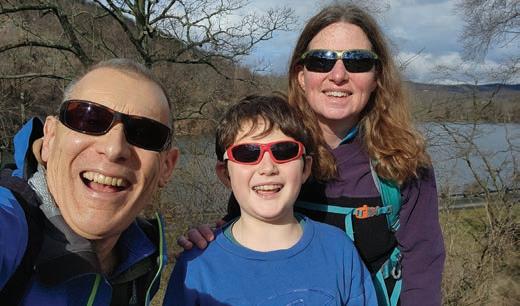
 Appalachian Trail signpost in Bear Mountain State Park.
Civilian Conservation Corps-built Bear Mountain Lodge.
Craig, his wife, and son enjoying Bear Mountain State Park.
Appalachian Trail signpost in Bear Mountain State Park.
Civilian Conservation Corps-built Bear Mountain Lodge.
Craig, his wife, and son enjoying Bear Mountain State Park.
mountaineers.org 37
Anthony's Nose and Bear Mountain Bridge spanning the Hudson River.
A Date on Mt. Rainier
By Joan Burton, 73-year member and Mountaineers Books author
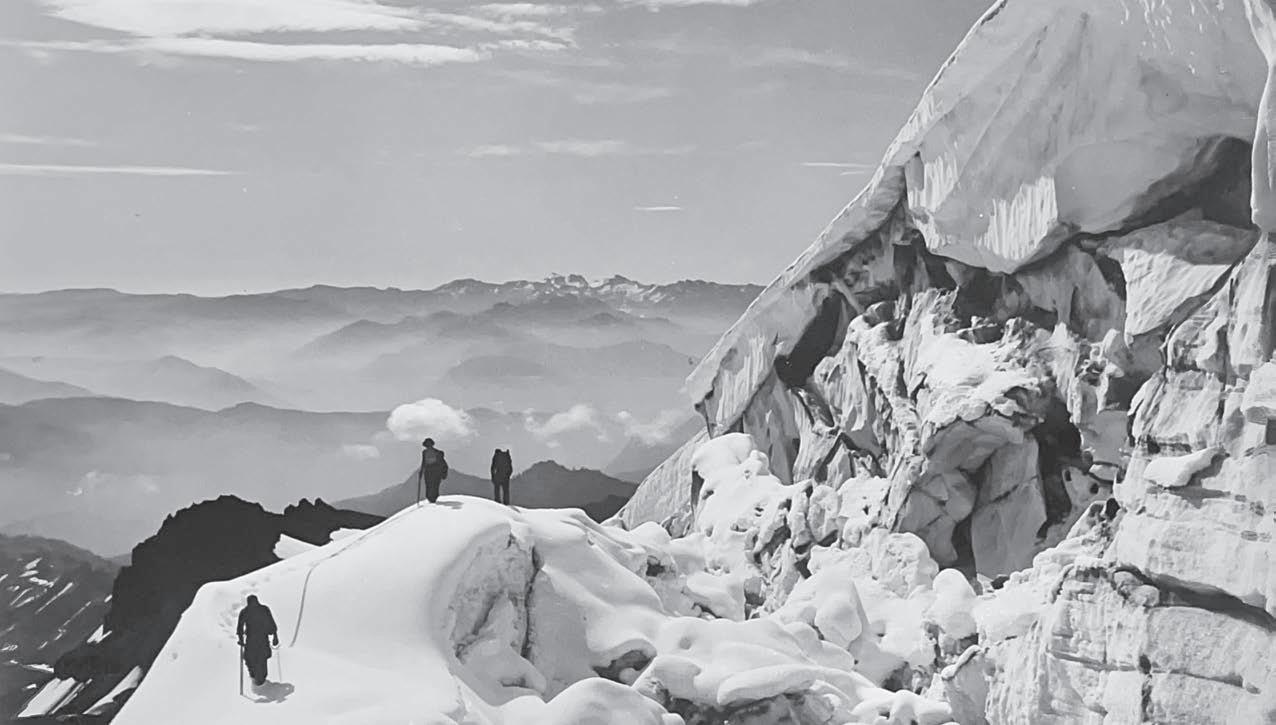
We were the luckiest teenagers we knew. In the spring of 1953, my sister (16) and I (18) learned we would spend ten days that summer in the alpine world of Mt. Rainier with two other teenage climbing course graduates, as well as renowned photographer Ira Spring. How did this happen? Ira had a contract with the publisher of a new magazine, Sports Illustrated.
Who would he choose? Teenage mountain climbers were not abundant in the early 1950s, let alone female mountain climbers. Ira went to the chair of The Mountaineers Climbing Committee, Harvey Manning. Harvey recommended my sister Carol and me, the Marston sisters, along with Gary Rose and Dave Nicholson. Carol and I knew Gary and Dave from the climbing course and considered them good friends. This was unbelievable news for us.
Picture perfect
I was excited, and struggled to believe we were going to spend a week exploring the glaciers on the south side of the mountain. When the time came, Ira led the six of us to our campsite at 10,000-foot Camp Muir. Ira was pleased with our willingness to pose for his pictures. We knew he was happy when he kept us laughing with his jokes. He made us dinners and breakfasts of Vienna sausages and Zoom hot cereal. Lunches were peanut butter and jelly sandwiches. The meals weren’t luxurious, but we didn’t care what we ate. We would have eaten anything for the opportunity to climb with Ira.
For the first week, we went out every day to pose for pictures on the glaciers next to enormous crevasses. Ira was shooting dramatic black and white stills and movies of us jumping the
crevasses and chopping steps. We willingly did everything he asked. Carol rappelled from a peak in the Tatoosh Range without a harness, only a rope and a smile on her face. The sun shone as we crossed crevasses on summer snow bridges (due to glacial melting, today’s climbers cross them on aluminum ladders). Our packs were old Trapper Nelsons, and we were roped together with 7/16th Manila rope. Regardless of the old gear, the photos were gorgeous. One of them is still on display in the Paradise Lodge, showing Dave, Gary, and me slogging through summer snow alongside a crevasse from the Cowlitz Glacier, just below Camp Muir.
A night on Rainier’s summit
The next adventure was the summit climb. Ira had talked the Park Service into giving us permission to camp on the summit. This was not usual practice at the time, and still today would be impermissible. We used an older route that is no longer considered safe, the Gibraltar Ledge. The ledge slopes downward to a drop-off where the Nisqually Glacier rests hundreds of feet below. In addition, random rocks can fall from above when they melt out of the ice wall above the ledge. At one point, several fell very close to my sister Carol. Watching from the side of the ledge, I was scared for her and screamed. But we trusted Ira to get us through it, and he did.
The summit climb began in darkness. Contours of the mountain gradually sharpened as shades of lavender, scarlet, and gold from the sunrise developed. Once on the summit, we set up tents, melted snow water, and rested. I remember filling a cook pot with snow and a package of dried prunes, then setting it on a steam jet for next day’s breakfast. We
38 mountaineer | spring 2024 retrorewind
Dave, Joan, and Gary trekking beside a crevasse on Rainier's Cowlitz Glacier. Photo by Ira Spring, courtesy of the Spring Trust for Trails.


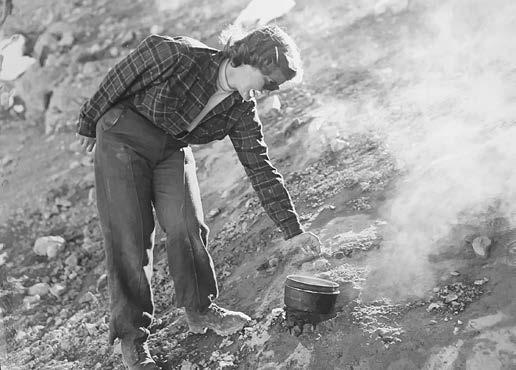

spent the rest of the day posing for photos and sunbathing in the 90-degree weather of Rainier’s summit.
As evening settled, we stood on the summit rim to watch the sunset. Looking west, we watched the sun as it dropped toward the Olympics and lit up Puget Sound with light, golden like molten metal. As the wind came up and the temperature fell, the cities and towns of Puget Sound began to light up, one by one. When we turned and faced east, the shadow of the volcano extended toward the wheat fields we imagined must be there. The shadow of the mountain dominated the skyline. Looking at the expansive view, I felt I was halfway to heaven.
Remembering a changed Rainier
We had an early night. The next morning, we ate soft, warm prunes with our Zoom breakfast, cooked by Mt. Rainier. We started to pack up as soon as breakfast was finished, wanting to get past the Gibraltar Ledge before the ice above it melted and the rocks came down at us again.
The ledge was quiet when we got there, but we hurried across it anyway. In fact, Ira was in such a hurry that he did not take off his crampons. That was a mistake. He fell forward, tripped on a rock, and dislocated his finger. The pain must have been severe, but he didn’t complain.
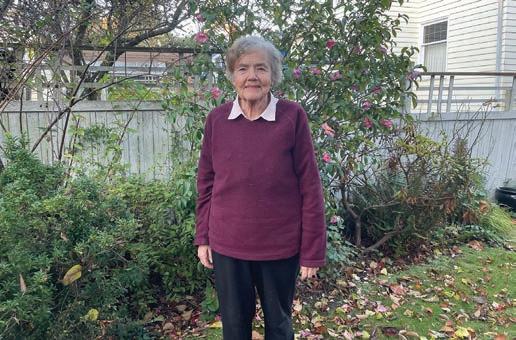
We dropped uneventfully to Camp Muir, packed additional camping items, and proceeded to Paradise. Ira loaded the car, checked to be sure we hadn’t left anything, and drove us home.
We didn’t want to leave. The experience had been so overwhelming that we were silent. We didn’t realize at the time that the ice caves we had traveled through were disintegrating and would soon disappear. We thought over what we had seen and done, and how fortunate we had been to experience Mt. Rainier’s beauty so closely. Today’s summit climbers don’t witness those same glacial formations, or watch the sun set over Puget Sound and the Olympics from Rainier’s summit.
We felt as though we were leaving the magic land of alpine beauty. Ira took great photos of that trip and the story of the four teenagers came out in the second issue of Sports Illustrated in 1954. It was titled “A Date on Mt. Rainier.” For the rest of his life, Ira called us “my teenagers."
mountaineers.org 39
Above: Pages from Ira's story in the 1954 Sports Illustrated magazine featuring the Marston sisters.Below: Joan checking on the prunes cooked by Mt. Rainier.
Photo by Ira Spring, courtesy of the Spring Trust for Trails.
Above: Carol rappelling from a peak in the Tatoosh Range with Mt. Rainier behind. Photo by Ira Spring, courtesy of the Spring Trust for Trails. Below: Joan in her garden. Photo by Mountaineers staff.
go guide

Virtual Education Center and Calendar
Check out our Virtual Education Center and Calendar, your home base for accessing all of our great virtual learning tools. Find activities, events, and classes held online, and browse our educational resources for skills and more.
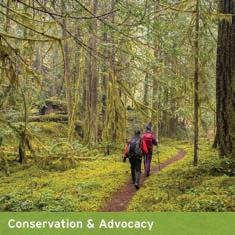




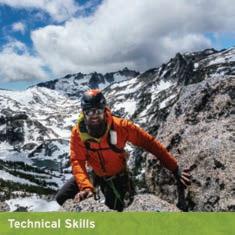
How to Get Involved
Step 1: Visit mountaineers.org/courses/virtual-education-center This is your first stop to find everything you need for outdoor education and exploration.
Step 2: Choose what you want to learn
There’s so much to explore! With a wide range of topics - from leadership tips to how to coil a rope - there’s something for everyone. We also have a special ‘Just for Fun’ section if you need a laugh.
Step 3: Decide what kind of learning experience you want to have
Would you prefer to read a blog or complete an online course? What about attending a live webinar with an open discussion? We offer multiple educational formats to choose from so that everyone can find what works for them.
What You'll Find 18 Online Courses 200+ Educational Blogs 25 Virtual Events & Activities
How to Sign Up for Activities
Step 1
Visit our website
www.mountaineers.org
Click on the big green 'Find Activities' button, or hover over the ‘Activities’ tab and choose ‘Find Activities.’
Step 2
Filter your activity search
Define your search using the filter options in the green column on the left. To view activities by location, choose ‘Map’ in the upper right.
Step 3
Select an activity & register
Click on the activity of your interest to learn more. If you like what you see, select the orange 'Register' button. You’ll be added to the trip roster and receive a confirmation email.
Note: Activities require registration unless otherwise noted. You will also need a current waiver on file with The Mountaineers to participate.
How to Sign Up for Events
Step 1
Visit our website
www.mountaineers.org
Click on the 'Upcoming Events' button on the left of the main page, or click 'More' and choose the 'Events' tab.
Frequently Asked Questions
Step 2
Browse for local events
Scroll down to view our most popular events, or choose a branch or program center calendar for more events in your area. Browse through your options, and click on an event to learn more.
Step 3
Select an event & register
Many events are free but require you to RSVP via the orange RSVP button. Events that require tickets will have a link for online ticket purchases.
What if I’m not a member? Many of our activities – especially day hikes and urban adventures – are open to the general public. You simply need to sign up for a guest membership at www.mountaineers.org/join. Guests can participate in two activities for free before joining.
What are some easy ways to get started? Sign up for an activity without prerequisites. These include day hikes, backpacking trips, stewardship activities, photography outings, and occasional sailing opportunities! Also, consider taking a basic or introductory course like Basic Snowshoeing, Introduction to Rock Climbing, Navigation, and much, much more! Visit www.mountaineers.org/courses to see what’s currently available.
How are events and activities different? Activities are primarily daylong outings that require participants to use skills in an outdoor setting. Examples include hikes, naturalist walks, or snowshoeing – in short, you are outside doing something. Events are open to the community, and are primarily opportunities to see presentations and socialize. Examples include summer picnics, branch banquets, and speaker series like BeWild, Walking the Wild, and the Adventure Speaker Series.
What if I don’t meet the prerequisites for an activity? Some of our technical activities, like climbing and kayaking, have prerequisite skill requirements. If you want to learn the prerequisite skills, we encourage you to take one of our courses. If you already have the prerequisite skills, you might qualify for equivalency. Email info@mountaineers.org and we will help you apply for equivalency so you can participate at the appropriate skill level.
Why do some activities say ‘Leader Permission Required’? All of our Mountaineers activities are led by volunteers. To ensure everyone on a trip has a set of specific skills, some volunteers require you to contact them in advance to participate. Before signing up for a trip that requires leader permission, please contact the leader by clicking on their name in the course/activity listing and send them an email. You can always email our Member Services team with questions at info@mountaineers.org.
What if the activity is full? Sign up for the waitlist! Yes, it works. We have roughly a 10-20% drop-out rate in courses and activities, so spots often become available.
mountaineers.org 41
Introductory Course Overview
The Mountaineers is a volunteer-led community built around sharing knowledge and skills to safely recreate outdoors. We offer courses every season and some all year round. The same course may be offered by multiple branches, and you can take a course with any branch. Exploring our clinics and seminars is also a great way to refine or expand your existing skills. Practice skills taught in our courses, learn about new techniques or gear, and explore new possibilities within our organization, like becoming an activity leader. Our clinics and seminars are often open to both our membership and the general public.
To learn when our courses are coming, take a look at our course calendar:
First Aid
Basic Wilderness Navigation
Avalanche AIARE Level 1
Backpacking and Wilderness Skills
Ski & Snowboard Mountaineering
Basic Wilderness Navigation
Frontcountry & Backcountry Trail Running
Winter Camping Fastpacking
Basic Alpine Climbing
Basic Alpine Scrambling
Rock Climbing: Learn to Belay & Intro to Rock
Basic Snowshoeing
Cross Country and Skate Skiing
Canyoning
Basic Sea Kayaking
Sailing
Whitewater Packrafting
Basic Photography
Basic Bikepacking
Flatwater Packrafting
Please visit www.mountaineers.org to see current course listings and to sign up.
Course selection varies by branch. Registration usually opens 1-3 months prior to the start of the course.
42 mountaineer | spring 2024
ALPINE CLIMBING COU R S COURSEE B A S I BASICC
KPACKINC BACK ING PAC BACKPACKING COURSE COU R SE AB S I C NATUR E P HOTOG R A P YH COU R SE AB S I C NATUR E P HOTOG R A P YH COU RSE FIR S T AID D COU RSE FIRST AID
ACKPACKING
Updated October 2022
Conditioning Hiking Series
Introduction to the Natural World
Outdoor Leadership Seminars
outdoorcenters
Open to Mountaineers members and the general public, our lodges provide visitors with unparalleled access to skiing, snowshoeing, hiking, and more. The Mountaineers is also home to the Kitsap Forest Theater, a historic outdoor theater showcasing two musical productions a year which are open to the public and a family favorite.
LODGE WEBPAGES Information about schedules, availability, meals, group rentals, and special events can all be found on

Baker Lodge
mountaineers.org/bakerlodge
the lodge webpages. You can also book your stay online. To access our lodge webpages, visit the direct links listed below or go to mountaineers.org, click on ‘More’ in the top menu, and then click on ‘Locations & Lodges’ in the dropdown menu.
VOLUNTEER Our lodges and the Kitsap Forest Theater are run by dedicated volunteers, and they can use your help! Visit their webpages to learn how you can contribute to the teams that keep our outdoor centers running.

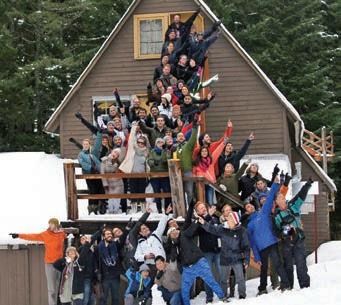
Mt. Baker Lodge, above Picture Lake and near Artist’s Point in the North Cascades, is a gorgeous place for a get-away. The lodge is located within walking distance of the Mt. Baker ski area as well as numerous hiking trails.
Stevens Lodge
mountaineers.org/stevenslodge
Nestled near the Stevens Pass ski area, this rustic ski-in/skiout lodge is open to PCT thru-hikers and mountain bikers in August and September, and skiers in the winter. Tired of the hustle and bustle of the big city? Come for a quiet respite to a cabin in the woods, with bunks for the whole family. Several trails are a short walk or drive from the lodge. The lodge is open Wednesday to Sunday during the winter when the ski area is open.
Meany Lodge
mountaineers.org/meanylodge
Meany Lodge is The Mountaineers oldest winter sports resort, located approximately 60 miles east from Seattle off I-90 near Stampede Pass and surrounded by the OkanoganWenatchee National Forest. Meany Lodge provides a warm family environment for all - perfect for winter and summer adventures alike. During the ski season, the lodge operates a rope-tow on our ski hill for ski lessons, cross-country skiing, and snowshoe excursions. Join us in March for our annual Patrol Race.

Kitsap Forest Theater
foresttheater.com
We’re thrilled to set the stage for another enchanting season in 2024! Prepare to be swept away by the boundless imagination and storytelling of two lively and funny musicals — Roald Dahl's Matilda, the Musical and Rodgers + Hammerstein's Cinderella (Broadway version). These mesmerizing, familyfriendly shows promise to light up hearts of all ages, and what better way to experience them than under the verdant canopy of the Kitsap Forest Theater?
Don't miss a single note! Secure your spot today with our exclusive two-show package. This is not just another theater outing; it’s a tradition, an enchanted experience that brings families and friends together year after year. Make sure you're part of the magic! Let’s make this season a celebration of imagination and wonder like no other.
Volunteer opportunities: property upkeep, cooking, helping with sets, costumes, ushering/parking during shows. We offer an Adventure Camp for grades K-4 and a Theater Camp for grades 5-8.
Baker Lodge
Stevens Lodge
mountaineers.org 43
Meany Lodge
branchingout
BELLINGHAM
EVERETT
BELLINGHAM
Chair: Nathan Andrus, nathan.andrus@gmail.com
Website: mountaineers.org/bellingham; bellinghammountaineers.com
COURSES & ACTIVITIES: avalanche safety, navigation, climbing, first aid, hiking, scrambling, stewardship and conservation.
You’ll find the Bellingham Branch tucked alongside the upper craggy expanse of the North Cascades. We enjoy easy access to the peaks that drain into the Nooksack and Skagit River basins. Our close-knit community offers climbing courses, hiking trips, and backcountry adventures in a diverse, inclusive, and supportive environment. We’re also home to one of the most popular Mountaineers getaway destinations, Mt. Baker Lodge.
Branch Council meetings are on the fourth Tuesday of each month. Visit our branch calendar for details.
EVERETT
Chair: Nick Mayo, nicholas.e.mayo@gmail.com
Website: mountaineers.org/everett
COURSES & ACTIVITIES: avalanche safety, backcountry skiing, climbing, cross-country skiing, first aid, hiking & backpacking, navigation, scrambling, sea kayaking, snowshoeing, and stewardship.
Founded in 1911, the Everett Branch offers several programs. As a smaller branch, we value companionship and are excited to restart inperson events including our Salmon Bake, Gear Grab & Potluck, Annual Awards Banquet, and more. Check our branch calendar for details. Our branch is also known for our unique Lookout and Trail Maintenance Committee, which restored the Mt. Pilchuck Lookout and continues to maintain the historic Three Fingers Lookout. Branch Council Meetings are held every other month to discuss new and ongoing initiatives and are open to all. We host a combination of hybrid and fully remote meetings depending on the month. As we ramp up our in-person events and programs, we are looking for talented and passionate volunteers to make an impact. Please reach out to Nick Mayo (email above) for details.
KITSAP
Chair: Melissa White, melissa.white@gmail.com
Website: mountaineers.org/kitsap
COURSES & ACTIVITIES: climbing, exploring nature, first aid, hiking & backpacking, navigation, outdoor leadership, scrambling, sea kayaking, snowshoeing, and youth & family.
The Kitsap Branch draws members from throughout western Puget Sound, from Gig Harbor to the Olympic Peninsula, including Pierce, Kitsap, Jefferson, and Clallam counties. Join us at our program center, conveniently located in Bremerton.
Branch Council Meetings are held in January, April, July, and October. Our annual branch celebration is in December, please join us!
SEATTLE
Chair: Craig Kartes, c.kartes@outlook.com
Website: mountaineers.org/seattle
COURSES & ACTIVITIES: avalanche safety, backcountry skiing, bikepacking canyoning, climbing, first aid, folk dancing, hiking & backpacking, naturalists, navigation, outdoor leadership, night sky, packrafting, photography, retired rovers, sailing, scrambling, sea kayaking, snowshoeing, stewardship, and urban walking.
The Seattle Branch began as the sole club location in 1906 when The Mountaineers was founded. Our Meet The Mountaineers open houses are held about once a month and are a great way for new and prospective members to learn about our many offerings. Our branch is also home to the Seattle Program Center, which features a bookstore, indoor and outdoor climbing walls, event spaces, and more.
Branch Council meetings are held every other month to discuss new and ongoing initiatives. We’re growing rapidly and actively seeking people to support our community. Visit our branch calendar for details and reach out to the branch chair if you are interested in volunteering.
FOOTHILLS (I-90/I-405 CORRIDORS)
Chair: Brad Peacock, bmpeacock@aol.com
Website: mountaineers.org/foothills
COURSES & ACTIVITIES: AIARE avalanche safety, backcountry and downhill skiing, climbing, conservation and stewardship, cross-country skiing, first aid, GoHike, hiking & backpacking, navigation, scrambling, snowshoeing, urban walking, and trail running.
The Foothills Branch is the club’s newest branch, founded in 2004 and encompassing the eastside communities along the I-90 and I-405 corridors. In addition to our educational and activity programs, we host film screenings, guest speakers, and stewardship events with the Mountains to Sound Greenway Trust, Shadow Lake Nature Preserve, WTA, and other
conservation-minded partners. We are also excited to be a close partner with Meany Lodge! Our branch is growing rapidly, and we are actively seeking people to support our community – no prior experience required. We invite you to get involved in branch leadership and committees to get our communities outside. Contact the branch chair if you might be interested.
Branch Council Meetings are held every other month (except summer) to discuss new and ongoing initiatives. All branch members are welcome! Visit our branch calendar for details.
TACOMA
Chair: Curtis Stock curtis@tacomamountaineers.org
Website: mountaineers.org/tacoma
COURSES & ACTIVITIES: avalanche safety, climbing, first aid, hiking & backpacking, navigation, outdoor leadership, photography, sailing, scrambling, sea kayaking, snowshoeing, and youth & family.
The second largest of all seven branches, the Tacoma branch maintains its own program center in the Old Town neighborhood of Tacoma, as well as the Irish Cabin property located near Mt. Rainier. A great way get involved is our Meet the Tacoma Mountaineers event, consisting of a meet-and-greet and a 90-minute interactive presentation giving you opportunities to learn about our history, our website, and how you can get involved.
Branch Council meetings are held every six weeks to discuss new and ongoing initiatives and general branch business. Visit our branch calendar for details.
OLYMPIA
Chair: Mandy Maycumber, manda_jo@live.com
Website: mountaineers.org/Olympia
COURSES & ACTIVITIES: avalanche safety, backcountry skiing, climbing, cross-country skiing, exploring nature, first aid, hiking & backpacking, navigation, outdoor leadership, scrambling, sea kayaking, stewardship, snowshoeing, wilderness skills, and youth & family. Our branch is known for its robust stewardship program.
Our Adventure Speaker Series runs from November through March and has a great lineup. Visit our website for details.
Branch Council Meetings are held at 6pm on the second Tuesday of the month, alternating in-person and Zoom, though Zoom is always available. Members are encouraged to attend. Contact Mandy Maycumber for details.
SEATTLE FOOTHILLS TACOMA
The Mountaineers is home to seven branches, each offering a number of courses and seminars. Our branches also host a variety of events like picnics, film screenings, and guest speakers. Regardless of which branch you join, you can sign up for offerings with any branch. Learn more at mountaineers.org/locations-lodges. KITSAP 44 mountaineer | spring 2024
OLYMPIA
Get Involved With Your Branch
Visit Your Branch Page Go to mountaineers.org and click on ‘More’ in the top menu; then click ‘Locations & Lodges’ and select your branch from the dropdown options. On your branch home page, you’ll find branch news, upcoming events, contact info, and more. You can also access your branch page using the direct links listed in the branch summaries.
Browse Branch Courses & Activities To see what’s available, visit mountaineers.org and click the big green ‘Find Courses’ button or ‘Find Activities’ button. You can then narrow your search by branch using the filter options in the green column on the left. Remember, you can sign up for courses and activities offered by any branch.
Branch Events With picnics, open houses, banquets, guest speakers, and more, our branches host an array of events for you to get involved. To check out what’s next, visit mountaineers.org/events. From this page, you can select your branch calendar.
Volunteer Our branches draw on people with a range of skills and interests to power their programs. Instructors, event planners, admin help, and more are all needed. Volunteering is a great way to plug into our community. Reach out to your branch chair to get started.
Branch eNewsletters Branch eNewsletters are a great way to stay up to date. To opt into these emails, visit mountaineers.org/profile. Login, then scroll down and make sure the box next to ‘Branch Communications’ is checked.*
*The Seattle Branch doesn't have a branch-wide eNewsletter, but several activity committees publish eNewsletters, including climbing, navigation, photography, and naturalists, and many activities have a Facebook presence. To learn more, contact the committee chairperson. To find a committee, input the committee name into our search bar at the top of our website.

membershipmatters
CONNECT
with member benefits
As a Mountaineers member you have access to: Courses, clinics, & seminars to gain lifelong skills
Activities to get outside and find community
Gear library access to help outfit your trips
Lodge access at our Baker, Meany, and Stevens lodges
20% off Mountaineers Books publications and Green Trails maps
10-70% off gear and experiences from our partners And more!
To learn more, visit mountaineers.org/membership/benefits
Photo by Eddie Kruger.
mountaineers.org 45
didyouknow
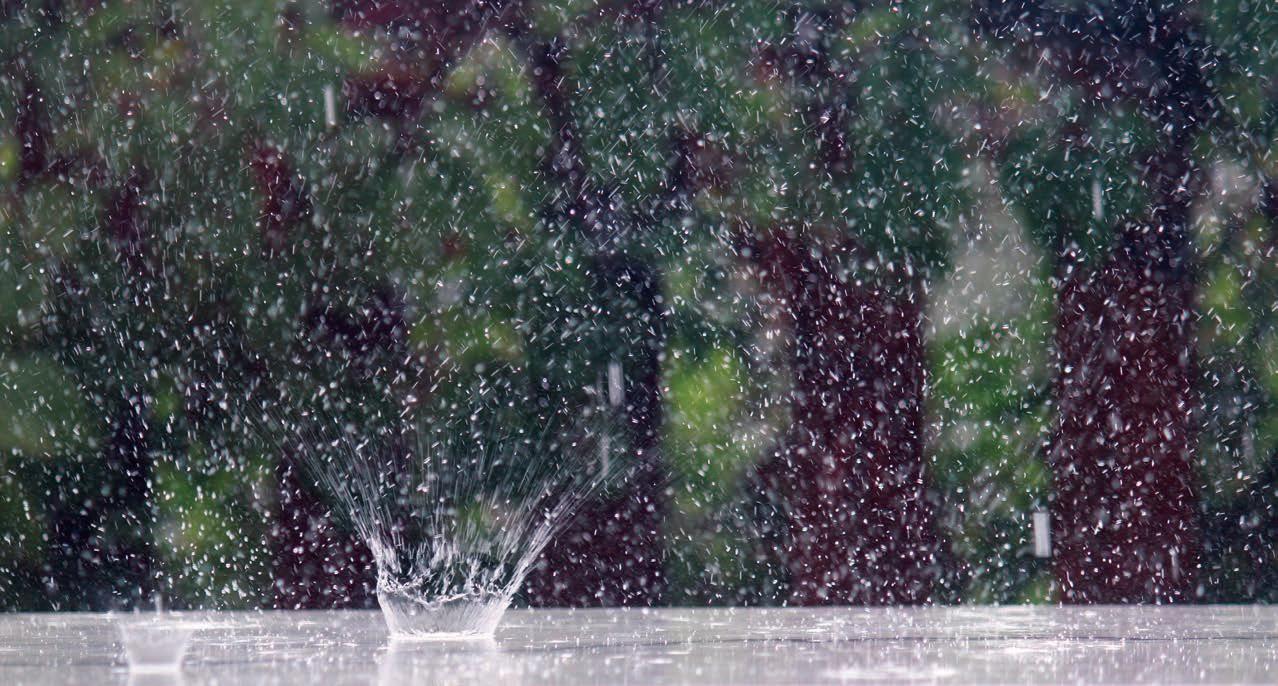
Winter is mostly gone. The ground is thawing. You watch as sunshine comes, then goes and dark clouds rumble in the distance. As the clouds move closer, the air changes and you smell the earth. The scent is sweet and almost savory, like honeysuckle flavored olive oil or carrot flavored cake. Breathe it in. Remember, as a child, playing in the rain? Breathe it out. It didn’t matter how wet you were, you kept playing as the earth reminded you it was spring with that delicate, thick, familiar scent: petrichor.
Petrichor is often known as the smell of rain, yet the true source of petrichor is much more complex. Petrichor emanates from the soil and falls from the sky. It’s pure, potent, packs a punch, and always leaves us wanting more. In fact, humans have made last-ditch efforts to savor the smell by trapping it in mason jars or infusing it in scented candles. Whether these methods preserve the integrity of petrichor, we can’t be sure, but we are fairly certain there’s nothing more nostalgic than the smell of spring.
What is petrichor?
While petrichor can be experienced in many ways, its smell is predominantly that of soil components – plant oils and Geosmin – that are produced in dry soil.
When water is scarce, plants release rich oils to prevent seedlings from germinating, and the soil retains these oils through the dry season. The aroma of these plant oils contributes to the scent of petrichor but is not solely responsible. The main contributor to petrichor is Geosmin, a compound secreted through the spores of soil-dwelling bacteria. Geosmin is like the chocolate chips in a chocolate chip cookie – crucial, and debatably mandatory. Humans are particularly sensitive to Geosmin, detecting it at less than five parts per trillion. Without knowing much about scientific
Petrichor
By Bayley Stejer, Communications Associate
values, we can surely all agree that is very small, and our noses are very powerful.
From source to nose
When raindrops land on the surface of arid soil, they trap tiny air bubbles underneath. These air bubbles, holding Geosmin and plant oils, shoot upwards - like your favorite glass of champagne – and burst through the soil’s surface. As the air bubbles are released from the ground, so are the aerosols. This scent is then picked up and carried great distances by the wind, which is why you often smell petrichor before you feel the rain.
Petrichor also falls from the sky. More specifically, petrichor comes from the protective atmospheric layer, ozone. The smell of ozone is known to be reminiscent of the chlorine at public pools that definitely kills your swim neighbor’s pee. During thunderstorms, ozone is produced when lighting splits oxygen and nitrogen molecules high in the atmosphere. Then, the rain and wind bring the scent down to Earth.
Spring is in the air
In spring, humans experience petrichor with upmost intensity, even when rain isn’t imminent. Petrichor is sensed when sunshine thaws the soil’s surface, releasing reserves of Geosmin and plant oils held underground through winter. Gardener’s release Geosmin when they turn their garden beds to prepare for planting, just like farmers do as they plow their fields. Over time, we’ve come to subconsciously celebrate this smell of tilling soil, the arrival of rain, and therefore the arrival of petrichor, harboring deeply imprinted joy and nostalgia each spring. We may experience petrichor in a variety of ways, but one thing remains: our human kinship with the sweet air of spring.
46 mountaineer | spring 2024
Photo by Skye Michel.
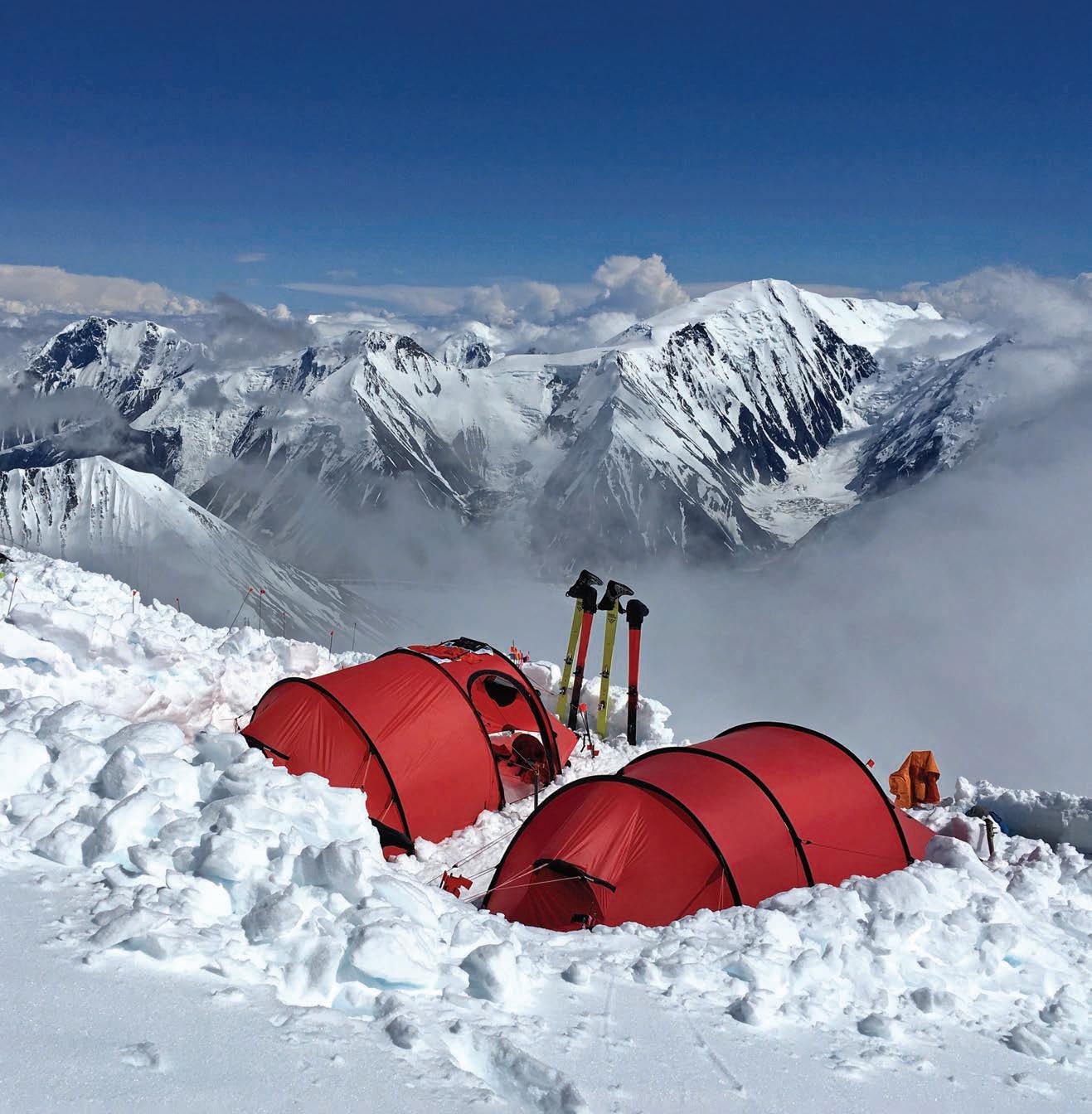
For 50 years, Hilleberg has been making the highest quality tents and shelters available. Developed in Sweden, manufactured in Europe, and used worldwide, Hilleberg tents and shelters offer the ideal balance of high strength, low weight, ease of use, and comfort. hilleberg.com 1-866-848-8368 order a Free catalog: Facebook.com/HillebergTheTentmaker 1971 2021 ce le br at in g
Miyazaki Hilleberg: Tents for any mountain, any weather, anywhere. Hilleberg: Tents for any mountain, any weather, anywhere.
Yoshiko




Join Us Virtually @ 7pm Virtual ticketholders can participate in the online auction and view the live broadcast. All proceeds from our Annual Gala support The Mountaineers commitment to ensuring every individual can find inspiration and belonging outdoors. Secure your virtual ticket today: mountaineers.org/gala2024 Featuring Annual Gala Adventure with Purpose The Mountaineers Saturday April REINHOLD MESSNER & RUE MAPP 6





 Tom Vogl Mountaineers CEO
Tom Vogl Mountaineers CEO


 Skye Michel skyem@mountaineers.org
Photo by Eleanor Lewis.
Skye Michel skyem@mountaineers.org
Photo by Eleanor Lewis.








































































 Appalachian Trail signpost in Bear Mountain State Park.
Civilian Conservation Corps-built Bear Mountain Lodge.
Craig, his wife, and son enjoying Bear Mountain State Park.
Appalachian Trail signpost in Bear Mountain State Park.
Civilian Conservation Corps-built Bear Mountain Lodge.
Craig, his wife, and son enjoying Bear Mountain State Park.






















